
CALL US: (800) 859-1870 We answer the phone!!

Crane Hand Signals – With Pictures
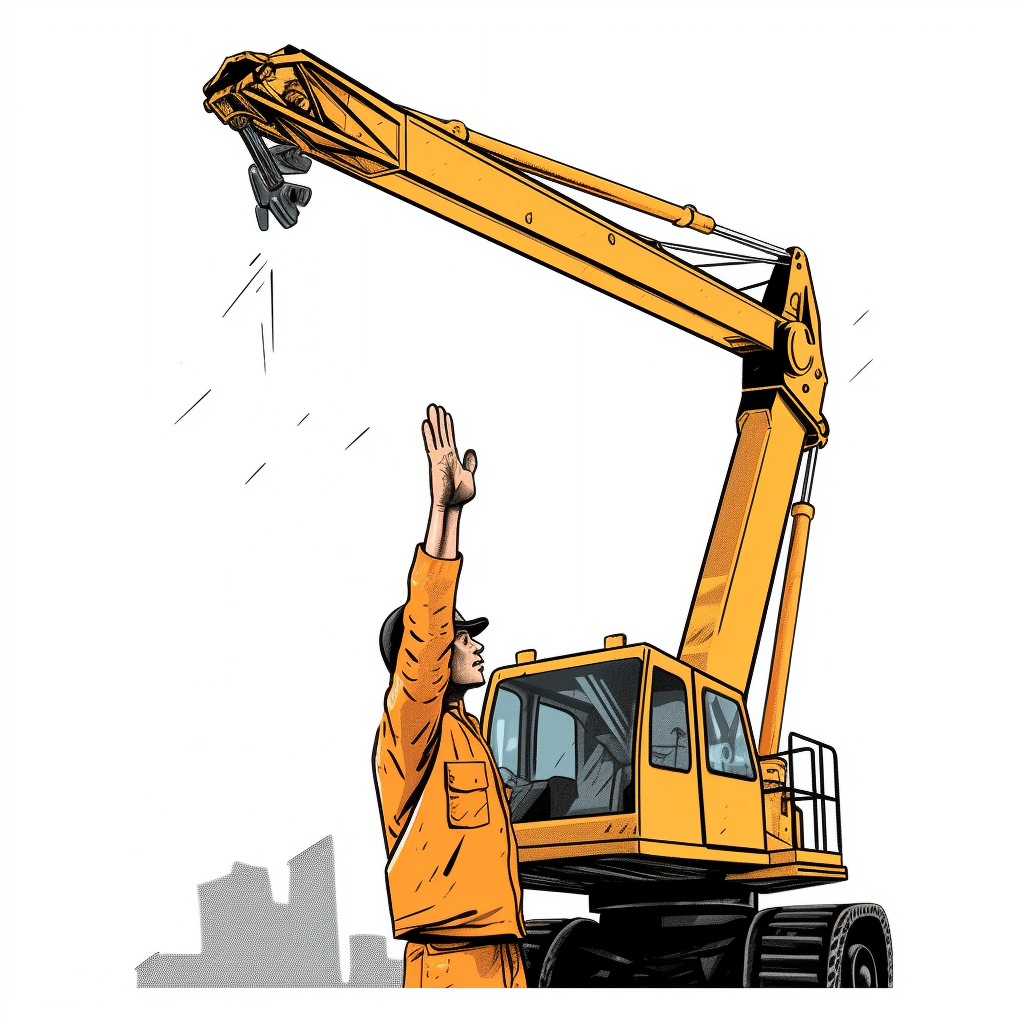
Understanding crane hand signals is vital when working with large construction equipment.
Whether you’re a crane operator or a signal person, understanding crane hand signals can help you and fellow workers stay safe by avoiding accidents and injuries.
You’ve come to the right place if you’re new to crane operation or need a refresher on the different hand signals.
Please continue reading to educate yourself on the standard signals for crane operation. We also offer a full crane safety training program.
Table of Contents
Why Use Crane Hand Signals Instead of Voice Signals?
Construction zones are noisy environments with a lot going on in the background. Hearing your coworkers speak is nearly impossible when a job site is busy.
Additionally, the crane operator’s view is often limited, so they need someone who can see for them and signal them on the actions they must take.
Hand signals were created as a low-tech, simple solution for these issues. When a crane operator sees the signal person making gestures, they know what to do.
There are a variety of safety products that can help train individuals on these signals.
Crane Operator Hand Signals Promote Construction Site Safety
With the crane operator’s hand signals, you can help promote construction site safety because workers can easily communicate with each other.
There is clarity about what direction, speed, or action the crane operator should take.
The hand signal person can see everything around the crane, eliminating many potential hazards on the job site to improve safety. (For even more, check out our write-up on Crane Safety Tips ).
The Role of a Crane Hand Signal Person
This individual is responsible for acting as the lift director and communicating with the crane operators through hand signals. They indicate what actions to take for the safe operation of the machine.
Each hand signal needs to be well-executed to avoid devastating accidents. One wrong movement could lead to equipment damage or injuries.
Every Signal Person and Crane Operator Should Know These Crane Hand Signals
Because the crane hand signals indicate the actions that should be taken in various situations, every signal person and crane operator needs to know the standard hand signals.
If not, there could be devastating consequences.
What are the hand signals for a crane?
Stop Signals
Stop signals are some of the most important gestures for a signal person and crane operator to learn.
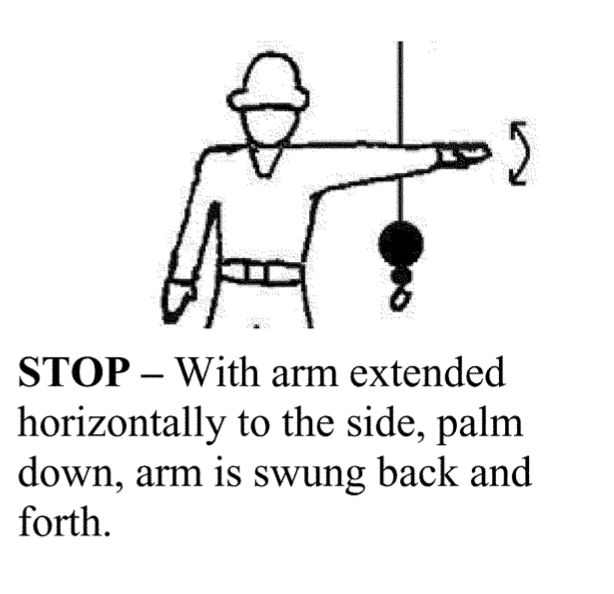
To signal to stop, stretch one arm out with your palm facing downwards. Then, swing that arm back and forth while touching your chest and back to the side.
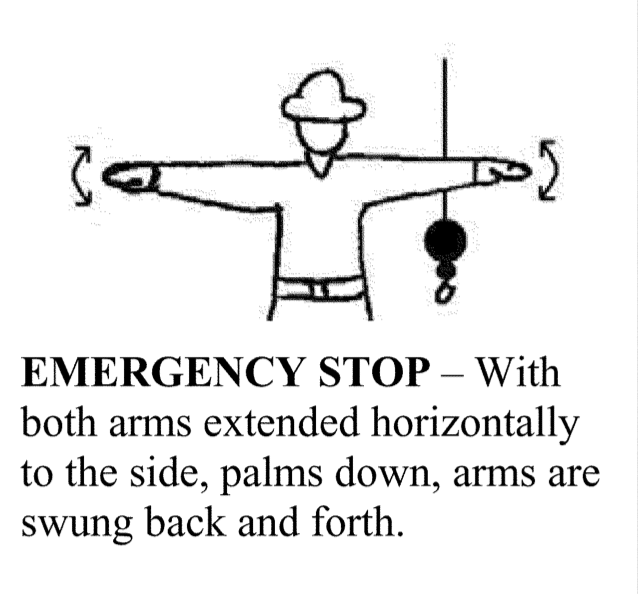
Emergency Stop
The standard method and movement to signal an emergency stop must be executed properly to avoid catastrophe.
For an emergency stop, spread both your arms with your palms faced downward. Then swing your arms to and fro, touching the chest, then back out to the sides.
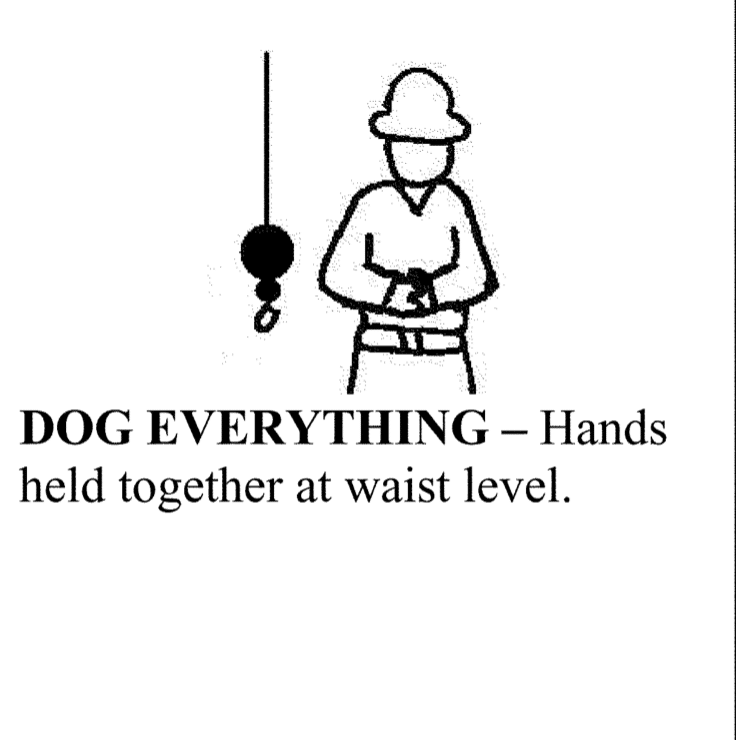
Dog Everything
What does dog everything mean on a crane? It means “pause.”
To signal that a person dog everything, you must clutch both hands together and hold them in front of your belly button at waist level.
Travel Signals
Hand signals help communicate to the crane operator how to direct the crane’s movement safely.
Remember that there are different cranes, such as crawler, telescopic, and locomotive cranes.
Travel for Mobile Cranes
Point your fingers upward with your hand extended out in front of your body, pushing inward and outward in the desired direction.
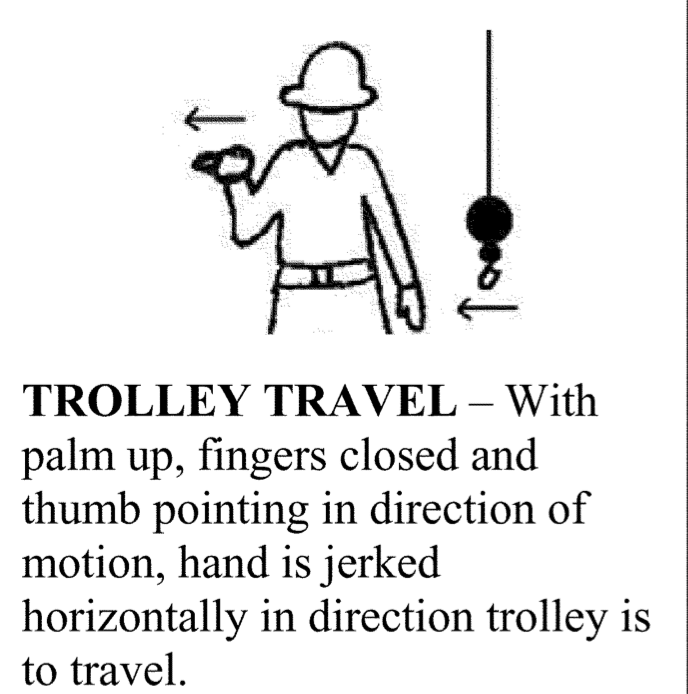
Trolley Travel for Tower Cranes
To indicate trolley travel for tower cranes, point your thumb in the travel direction with your palm facing upward and your other fingers closed in a fist. Then move your thumb back and forth to indicate travel.
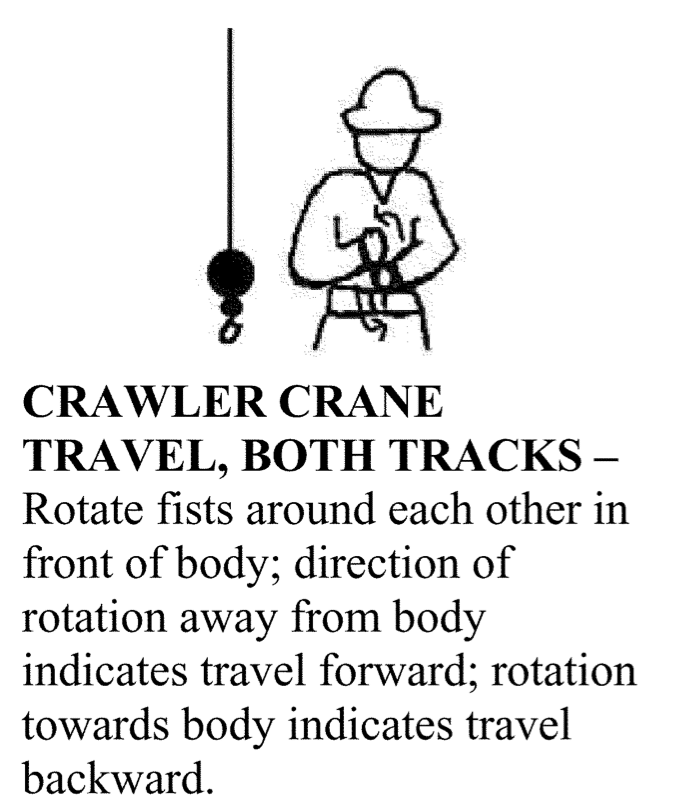
Crawler Crane Travel Both Tracks
To signal for crawler cranes travel (both tracks), spin your hands with your other fingers closed into a fist in front of you.
To indicate forward travel, you must rotate towards yourself. Rotation away from the body indicates backward travel.
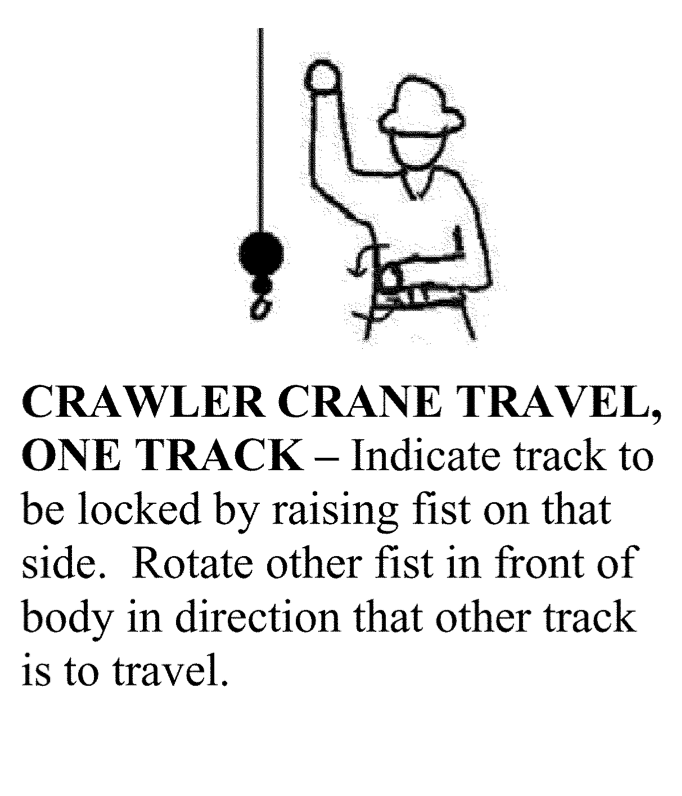
Crawler Crane Travel, One Track
First, you must lift a fist to indicate which track to lock; then spin the other fist in front of your body in small circles to show the pathway of travel.
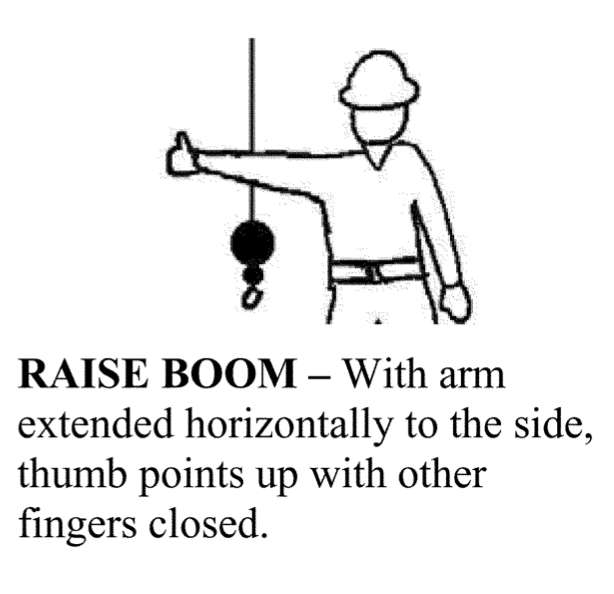
Boom Raise and Lower Signals
The boom is the long arm that extends from the crane. It can be raised and lowered.
You need to do special hoist hand signals to indicate whether the crane operator should raise or lower the boom.
Crane Signals Related to Raise or Lower Load with a Hoist
When a crane contains heavy loads, the operator needs to know what to do with them.
Load signals tell the operator whether to lift or lower the load using the main hoist or auxiliary hoist. The crane’s hoist is a long chain with a hook; this part links to the load.
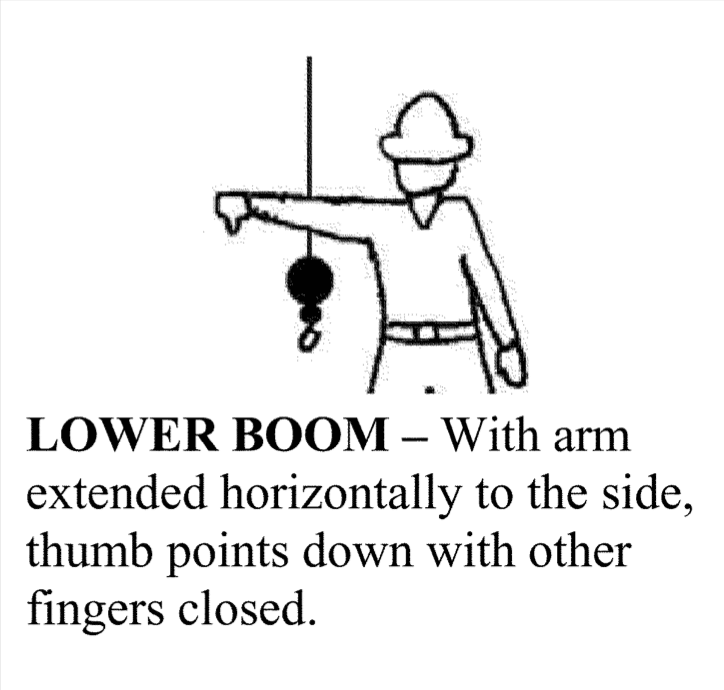
What does a thumbs down mean to a crane operator? It has to do with the boom.
To signal to lower the boom, stretch your arm out and point your thumb down with your fist closed.
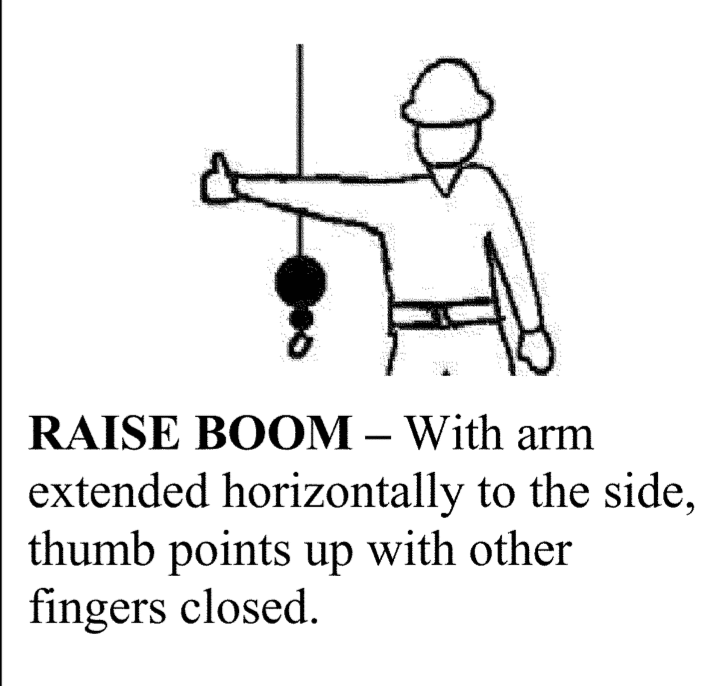
To raise the boom, stretch out one arm and point your thumb up with a closed fist.
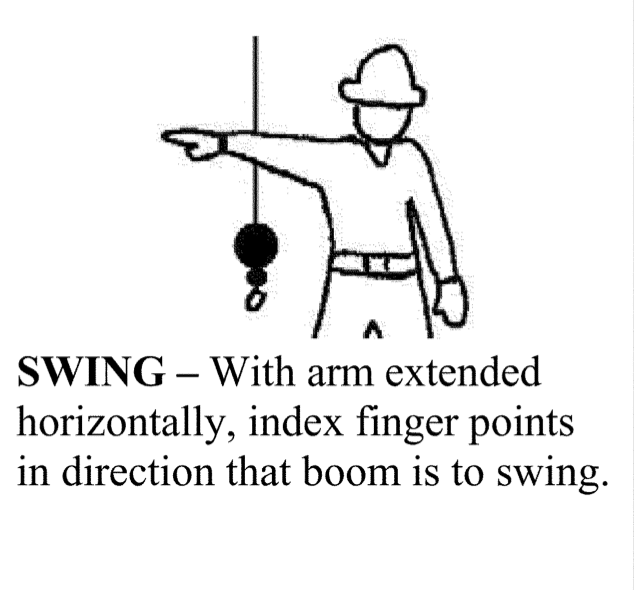
To tell the operator to swing the boom, you need to stretch your arm outward, then point your index finger in the direction it should swing.
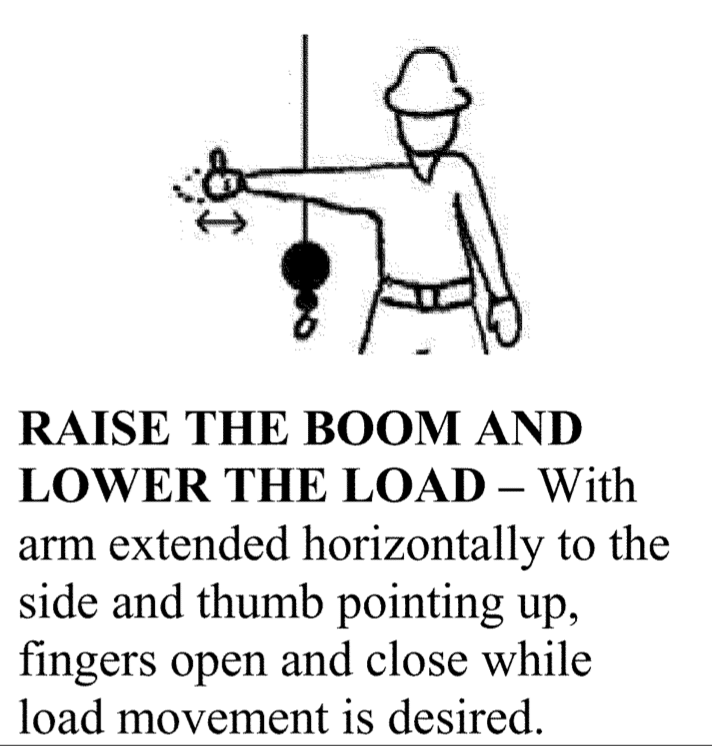
Raise Boom and Lower Load
Lifting and lowering the boom will change the load radius. Therefore, you may need a combination of commands to stay within secure operational boundaries.
You can let the crane operator know to raise the boom and lower the load by stretching out a single arm with your thumb pointing up while opening and closing your remaining fingers.
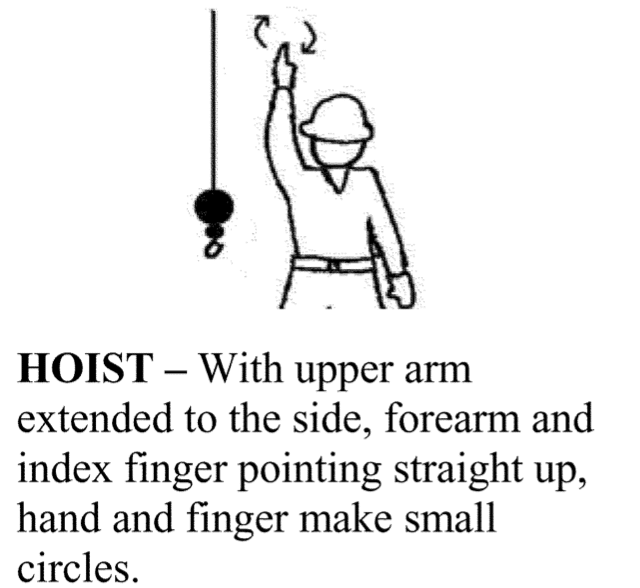
Hoist Load Hand Signal
To use the main hoist for the load, stretch your arm vertically, point your index finger toward the sky, then make small clockwise motions with the finger.
Lower Boom and Hoist Load signals
To have the crane operator lower the boom and hoist the load, you must reach your arm horizontally (thumb pointing down) and open and close your remaining fingers.
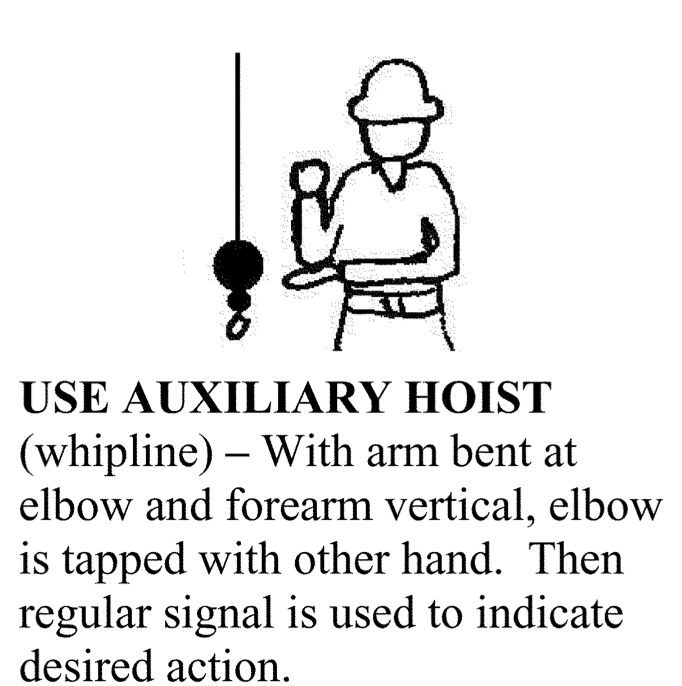
Use Auxiliary Hoist
With your bent at your elbow and your forearm vertical, tap your elbow with your other hand. Then use the regular signal to indicate the desired action.
Speed Signals
Sometimes the signal person must indicate that the operator should move slowly.
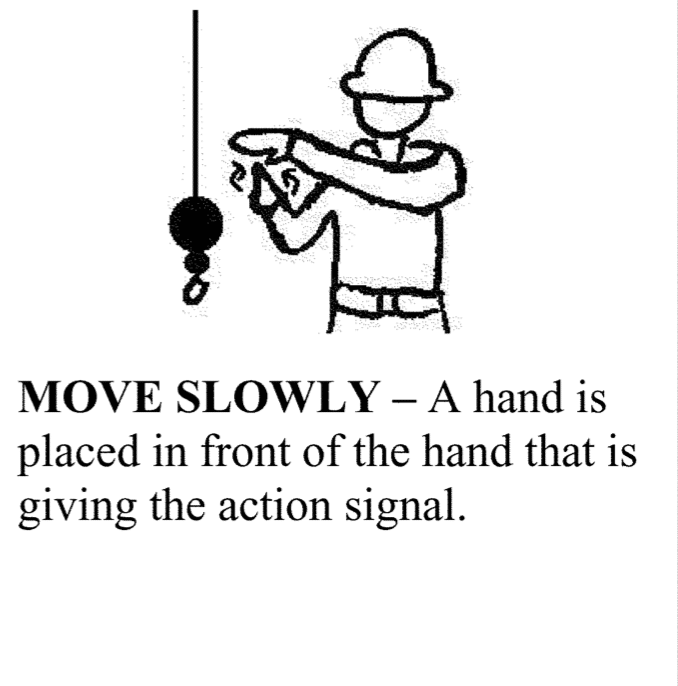
Move Slowly
To let the operator know to move slowly with the equipment, you must place your other hand above the hand and arm, giving the action signal.
Telescopic Cranes
Telescopic cranes can retract or extend boom lengths. Due to this special feature, they have special hand signals.
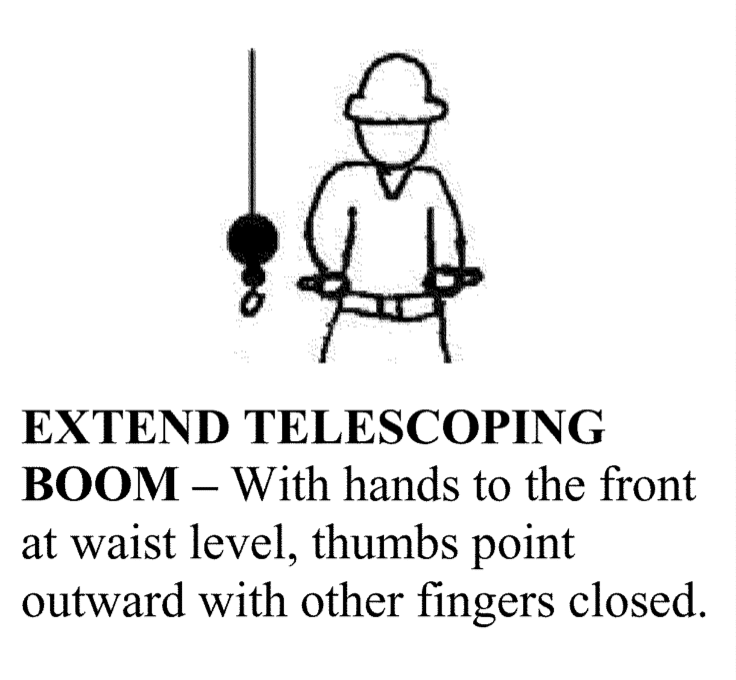
Extend Telescope
To let the operator know to extend the boom, place your hands at waist level and point your thumbs outward (with closed fist).
Retract Telescope
When you want them to retract the boom, place your hands at waist level and point the thumbs in with your fists closed.
Crane Hand Signals: Final Thoughts
Study and practice each hand signal to ensure you can do them properly. Remember, everyone’s safety (including yours) depends on your understanding of them.
It’s important to refresh your memory often to remain on top of your game.
Jason Hessom is a respected workplace safety expert with 25 years of experience in implementing employee safety training, designed to reduce on the job accidents and injuries. Mr. Hessom’s background also includes managing workers compensation claims, overseeing loss prevention programs and litigation cost containment. An independent consultant for Fortune 500 companies, Mr. Hessom has given lectures at the National Safety Council as well as other nationally recognized safety organizations. An Authorized Outreach Trainer for both OSHA and Cal/OSHA, he also holds several disability and workers compensation related certifications (CPDM, WCCA, and WCCP).
Review Cart
No products in the cart.

#1 Choice for Fasteners!
ITEMS IN STOCK SHIP WITHIN 24 HRS.
- 2922B844-3CF7-4523-BA77-4E7ECC6DCB0E@3x
An Introduction to Mobile Crane Hand Signals
- Previous blog
- Huyett Marketing Department
- 02/03/2022
- Updated 11/30/2023
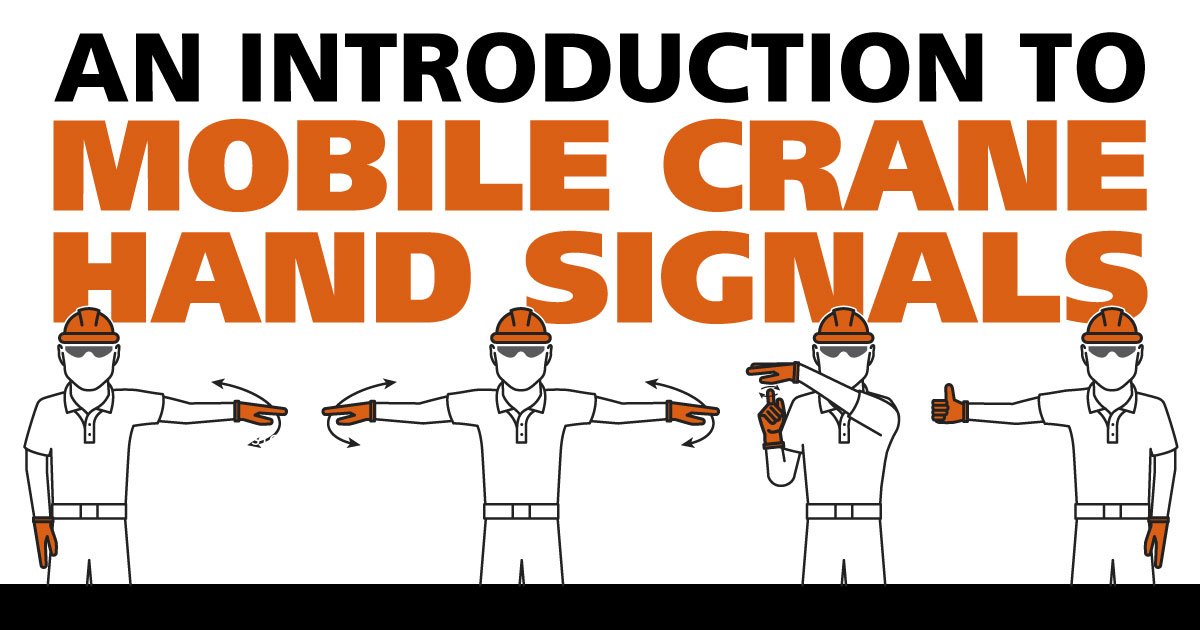
- The point of operation — the load's position and the area nearby — is not in full view of the operator,
- The operator's view is obstructed in the load's direction of travel, or
- There are specific safety concerns that lead the operator or the person handling the load to determine a spotter is necessary.
What Are Crane Hand Signals?
Crane signal chart.
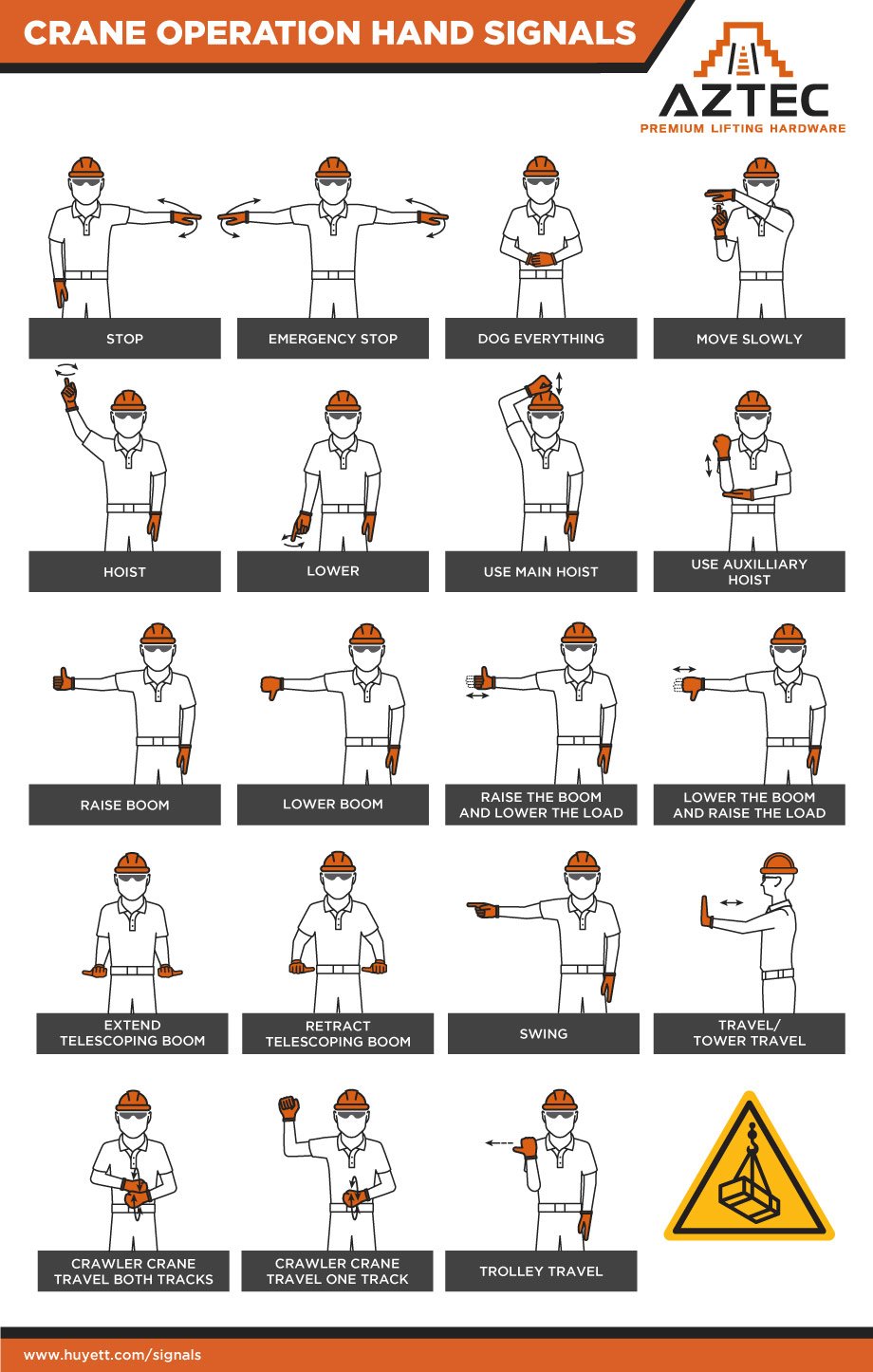
Why Use Crane Hand Signals Instead of Voice Signals?
Crane hand signals every spotter and crane operator should know, crane signals to stop or slow lifting operations.
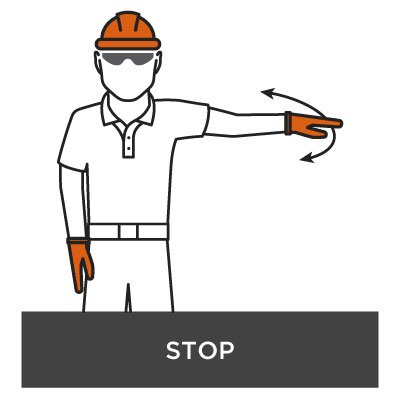
Emergency Stop
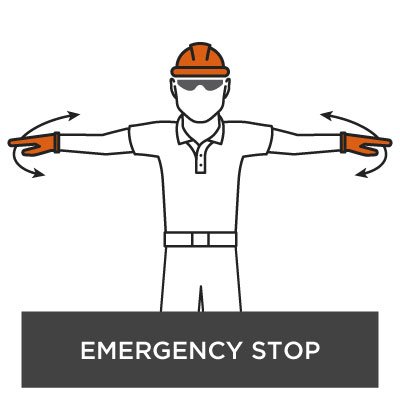
Dog Everything
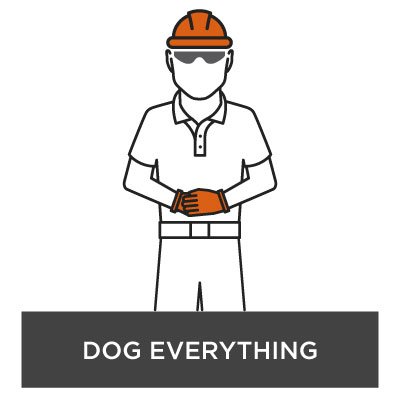
Move Slowly
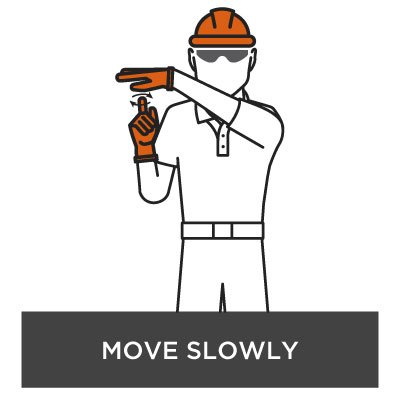
Crane Signals Related to Moving Loads with a Hoist
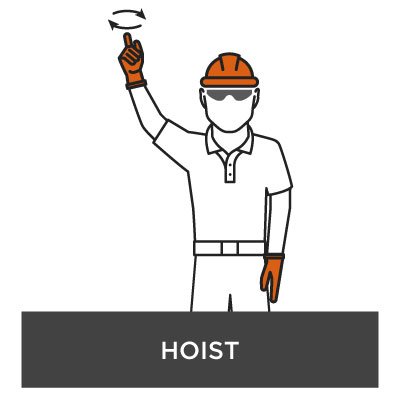
Use Main Hoist
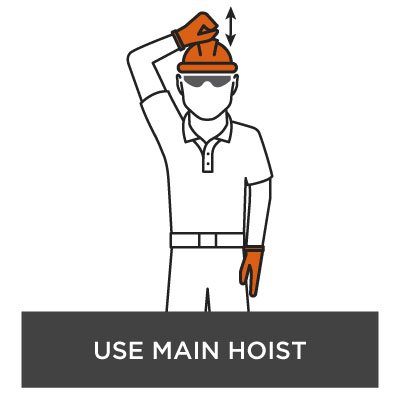
Use Auxiliary Hoist
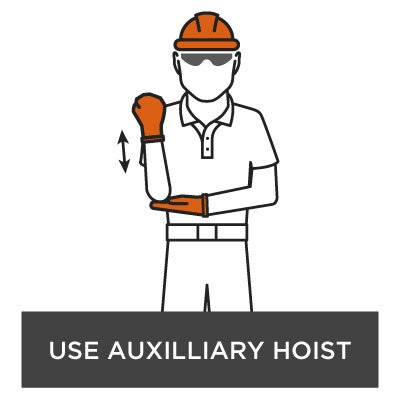
Crane Signals for Boom Operations
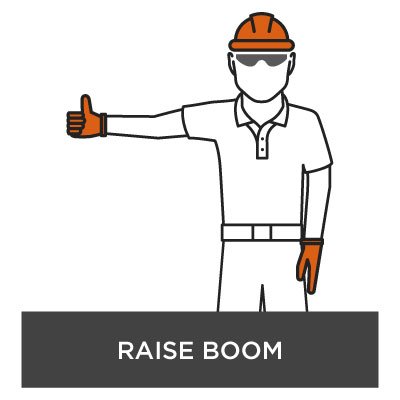
Raise the Boom and Lower the Load
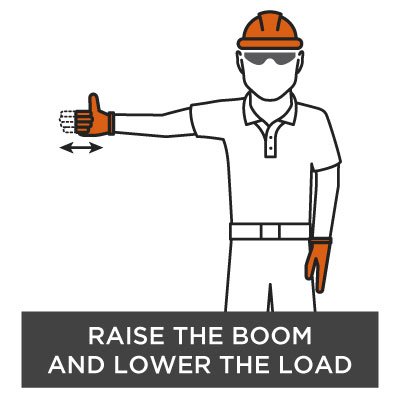
Lower the Boom and Raise the Load
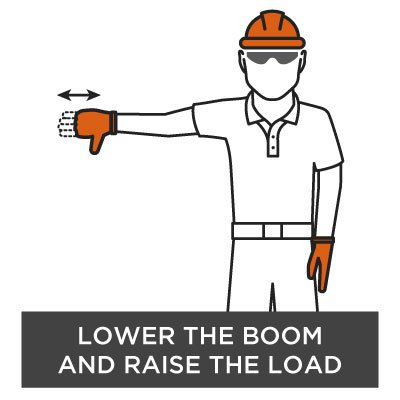
Extend Telescoping Boom
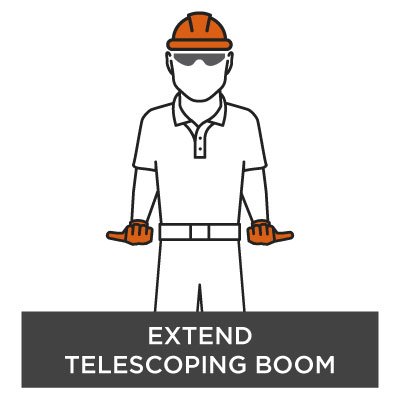
Retract Telescoping Boom
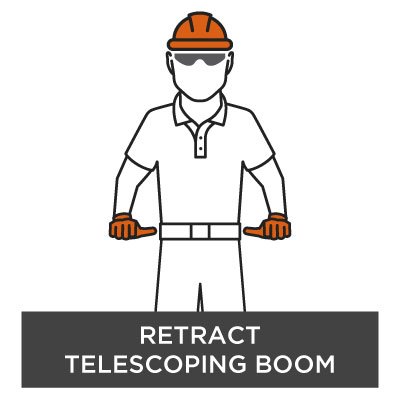
Movement Signals for Mobile Cranes
Travel/tower travel.
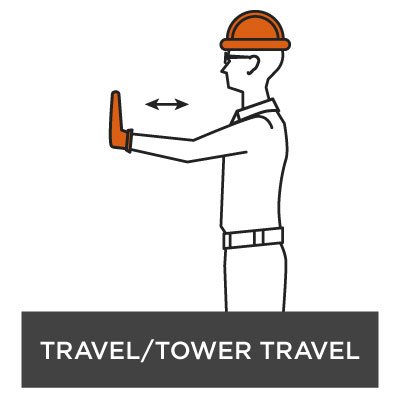
Crawler Crane Travel, Both Tracks
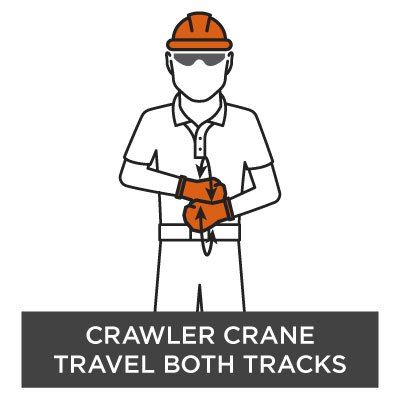
Crawler Crane Travel, One Track
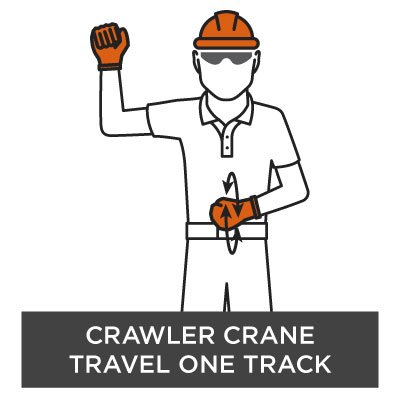
Trolley Travel
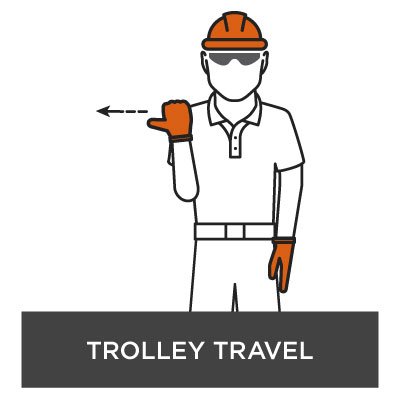
Crane Signal OSHA and ASME Regulations
- OSHA 1926.1419 - Signals-general requirements describe when a spotter must be provided and the types of signals that are permitted.
- OSHA 1926.1428 - Signal person qualifications describe the qualifications and knowledge a spotter requires.
- ASME B30.5 is a comprehensive safety standard for mobile and locomotive cranes, including standard hand signals.
- ASME B30.3 provides standards for tower cranes, also including standard hand signals.
Catalogs & Resources
We have the most comprehensive catalogs of hard-to-find, hard-to-make, and hard-to-buy parts on the planet – all under one roof.
Find What You Need


An official website of the United States government.
Here’s how you know
The .gov means it’s official. Federal government websites often end in .gov or .mil. Before sharing sensitive information, make sure you’re on a federal government site.
The site is secure. The https:// ensures that you are connecting to the official website and that any information you provide is encrypted and transmitted securely.

Occupational Safety and Health Administration
- 中文(简体) (Chinese-Simplified)
- 繁體中文 (Chinese-Traditional)
- Kreyòl ayisyen (Haitian Creole)
- 한국어 (Korean)
- Español (Spanish)
- Filipino/Tagalog
- Tiếng Việt (Vietnamese)
- By Standard Number
- 1926 Subpart CC App A - Standard Hand Signals
- Part Number: 1926
- Part Number Title: Safety and Health Regulations for Construction
- Subpart: 1926 Subpart CC
- Subpart Title: Cranes and Derricks in Construction
- Standard Number: 1926 Subpart CC App A
- Title: Standard Hand Signals
- GPO Source: e-CFR
Appendix A to Subpart CC of Part 1926—Standard Hand Signals

STOP - With arm extended horizontally to the side, palm down, arm is swung back and fourth.
EMERGENCY STOP - With both arms extended horizontally to the side, palms down, arms are swung back and fourth.
HOIST - With upper arm extended to the side, forearm and index finger pointing straight up, hand and finger make small circles.
RAISE BOOM - With arm extended horizontally to the side, thumb points up with other finger closed.
SWING - With arm extended horizontally, index finger points in direction that boom is to swing.
RETRACT TELESCOPING BOOM - With hands to the front at waist level, thumbs point at each other with other fingers closed.
RAISE THE BOOM AND LOWER THE LOAD - With arm extended horizontally to the side and thumb pointing up, fingers open and close while load movement is desired.
DOG EVERYTHING - Hands hel together at waist level.
LOWER - With arms and index finger pointing down, hand and finger make small circles.
LOWER BOOM - With arm extended horizontally to the side, thumb down with other fingers closed.
EXTENDED TELESCOPING BOOM - With hands to the front at waist level, thumbs point outward with other fingers closed.
TRAVEL/TOWER TRAVEL - With all fingers pointing up, arm is extended horizontally out and back to make a pushing motion in the direction of travel.

LOWER THE BOOM AND RAISE THE LOAD - With arm extended horizontally to the side and thumb pointing down, fingers open and close while load movement is desired.
MOVE SLOWLY - A hand is placed in front of the hand that is giving the action signal.
USE AUXILIARY HOIST - (whipline) - With arm bent at elbow and forearm vertical, elbow is tapped with other hand. Then regular signal is used to indicate desired action.
CRAWLER CRANE TRAVEL, BOTH TRACKS - Rotate fists around each other in front of body; direction of rotation away from body indicates travel forward; rotation towards body indicates travel backward.
USE MAIN HOIST - A hand taps on top of head. Then regular signal is given to indicate desired action.
CRAWLER CRANE TRAVEL, ONE TRACK - Indicate track to be locked by raising fist in front of body in direction that other ttrack is to travel.
TROLLEY TRAVEL - With palm up, fingers closed and thumb pointing in direction of motion, hand is jerked horiontally in direction trolley is to travel.
[75 FR 48173, Aug. 9, 2010]
Heavy Equipment and Construction Hand Signals
Using hand signals plays an essential role in a construction company because it can help your team stay safe. It is crucial that your team knows, uses, and understands hand signals while on a work site. Here is a guide that will help you understand the importance of hand signals and how to properly use them.
The Importance of Construction Hand Signals
Using hand signals means that you are communicating without talking, which can be crucial in a loud area. This allows you to communicate when words cannot be spoken and ensure the safety of your team. Construction site hand signals can help you indicate when to stop, go, which way to go, and if there are any dangers to be aware of.
Commonly Used Heavy Equipment Hand Signals
Here is the best guide for you if you’re looking for a list of the most common hand signals to use in construction site safety . Working on any project, especially a crane operation , the most successful teams have good communicators and coordination skills. Take a look at these common hand signals and make sure your team masters them.
1. Stop Signals
STOP – To ensure the crane stops, you will lift your arm straight to the side and your palm down. Then you will swing the arm. This indicates to the operator the crane needs to stop before it continues again.
EMERGENCY STOP – However, if there needs to be an emergency stop, both hands will go straight out with palms flat and then swing back in forth. If all activity needs to stop, the main person will clasp hands and place them at their waist.
2. Boom Signals
These signals tell the crane operator which maneuvers to do. Though to many people the term boom isn’t something they look forward to hearing, there is no booming involved.
RAISE BOOM – The first boom signal is a motion that will raise the crane. The person directing will extend their arm outward, close their fist and point their thumb upwards.
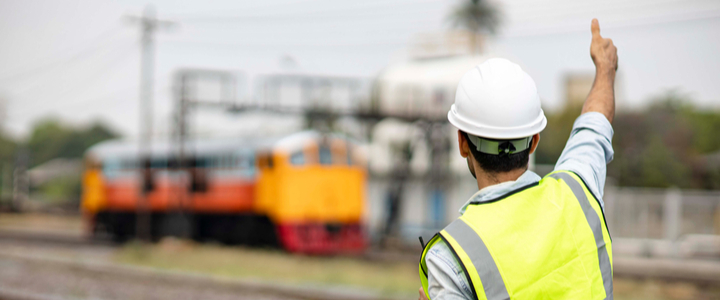
SWING BOOM – The signal person will extend the arm outward, horizontally, and use the index finger to point the direction. This will tell the other operator which direction the crane should swing.
LOWER BOOM – To indicate the operator needs to go lower, the director will hold their hand horizontally, do a fist and point their thumb downward.

EXTEND BOOM – The last boom signal tells the operator to extend the crane. The signal person will hold their hands away from their waist, creating a fist with thumbs outwards.
3. Loader Hand Signals
This signal is just as important as the other signals. It tells the operator what to do with the load once it has officially been lifted. There are two signals to keep in mind when teaching your team.
HOIST LOAD – The first one is the hoist signal which means to raise the load further. The signal person will extend their arms upward or vertically and create a fist. Then they will stick their index finger in the air and make small circles.
LOWER LOAD – The second load signal is the same action in the opposite direction. This will indicate the operator should load downwards. The signal person will extend their arm horizontally, make their hands into a fist, and then make small circles with their index finger.
4. Travel Signals
Moving a crane can be dangerous, and someone needs to direct the operator on where to go. There are a few basic signals your team should be aware of and what they mean.

MOBILE CRANES – The indicator will point their hands up and arms extended outwards. They will then push in the direction the crane should go.
TOWER CRANES – the signal person will bend their arms upward at the elbow. With their thumbs, they will point in the direction of travel.
CRAWLER CRANES (BOTH TRACKS) – Crawler cranes will have a signal person who turns their hands into fists. They will put them in front of their waist and rotate their hands. Rotating towards their body means the crane should go forward; away from their body means to go backward.
CRAWLER CRANES (ONE TRACK) – Travel on crawler cranes, but one track will require a person to signal whether to go backward or forwards. One fist should remain in front of the body while the other fist raises to the air to indicate which direction to move.
5. Speed Signals
SLOW DOWN – Speed can be controlled by the signal person. If the operator sees the signal person put one hand over the hand that’s doing the action, it means to slow down. This can be a crucial signal for safety.
Benefits of Universal Construction Hand Signals Training
Hand signals for construction equipment are a good way to ensure safety on a site and among your construction crew. It allows your team to communicate from a distance without words and can promote safety. There are some universal hand signals that most people will know and understand. This is also a way for people who speak different languages to have a way to communicate.
Safety By Design Values Construction Site Safety
Construction hand signals are the best way to ensure heavy equipment is used properly, and the team remains safe. Safety By Design offers ways to teach your crew the importance of these hand signals and will offer you a way to learn how to best teach OSHA hand signals .
Contact us online to start teaching your team about heavy equipment operator training now!
Share this post
Please register to unlock the toolbox talks from safety by design.
After the form is submitted, click on any”Download This Talk” button to view the Talk.
- Name * First Last
- * City State / Province / Region
If you opt in above we use this information to send related content, discounts and other special offers.
- Skip to main content
- Skip to site information
- Departments
Language selection
- Français

Scheduled maintenance - Thursday, July 12 at 5:00 PM EDT
We expect this update to take about an hour. Access to this website will be unavailable during this time.
Materials Handling - Crane and Hoist Hand Signals
On this page, when should the crane operator follow hand signals, who can give the hand signals or who can be a signaler, what should you do when in charge of signaling, what are examples of some common hand signals, what are some common hand signals for crawler, truck and locomotive cranes, what are some signals for crawler cranes only.
A crane operator should always move loads according to the established code of signals, and use a signaler. Hand signals are preferred and commonly used. A signaler may be required by law if the operator's view of the intended path of travel is obstructed.
- A person qualified to give crane signals to the operator.
- There should be only one designated signaler at a time.
- If signalers are changing between each other, the one in charge should wear a clearly visible badge of authority.
- A crane operator should move loads only on signals from one signaler.
- A crane operator must obey STOP signals no matter who gives it.
The signaler must:
- Be in clear view of the crane operator.
- Have a clear view of the load and the equipment.
- Keep persons outside the crane's operating area.
- Never direct a load over a person.
Hoist: With forearm vertical, forefinger pointing up, move the hand in a small horizontal circle.
Lower: With an arm extended downward, forefinger pointing down, move the hand in small horizontal circles.
Multiple Trolleys: Hold up one finger for block marked "1" and two fingers for a block marked "2." Regular signals follow.
Bridge Travel: Arm extended forward, hand open and slightly raised, make a pushing motion in direction of travel.
Trolley Travel: Palm up, fingers closed, thumb pointing in direction of motion, jerk the hand horizontally.
Stop: Arm extended, palm down, hold the position rigidly.
Emergency Stop: Arm extended, palm down, move the hand rapidly right and left.
Magnet Is Disconnected! : Crane operator spreads both hands apart, palms up.
Dog Everything: Clasp hands in front of the body. Means PAUSE. This signal can be used on potentially risky occasions such as when it has started raining, when the load doesn't fit the space for which it was planned, or when a bystander gets too close to the action.

Use Main Hoist: Tap fists on head; then use regular signals.
Use Whip Line (Auxiliary Hoist): Tap elbows with one hand; then use regular signals.
Raise Boom: Arm extended, fingers closed, thumb pointing upward.
Lower Boom: Arm extended, fingers closed, thumb pointing downward.
Swing: Point with a finger in direction of swing of a boom.
Raise the Boom and Lower the Load: Arm extended, fingers closed, thumb pointing upward, other arm bent slightly with forefinger pointing down and rotate hand in horizontal circles.
Lower the Boom and Raise the Load: Arm extended, fingers closed, thumb pointing downward, other arm with forearm vertical, forefinger pointing upward and rotate the hand in horizontal circles.
Move Slowly: Use one hand to give any motion signal and place the other hand motionless in front of the hand giving the motion signal. (Hoist Slowly shown as example.)
Retract Boom (Telescoping Booms): Both fists in front of body with thumbs pointing toward each other.
Extend Boom (Telescoping Booms): Both fists in front of body with thumbs pointing outward.
Turn Travel Track: this side in direction shown by revolving fist.
Travel Both Tracks: forward or backward by revolving fists.
- Fact sheet confirmed current: 2019-08-15
- Fact sheet last revised: 2013-09-05
You are using an outdated browser. Please upgrade your browser to improve your experience.
18 April 2024
- Asphalt Plant Broker.com
- Bitumen Broker.com
- Plant Finance Broker.com
- Road and Quarry.com
Ringway Jacobs Resurfaces Highway in World-First Gipave Trial
Intel announces sustainable ai with world’s largest neuromorphic system, revolutionizing robotics with the boston dynamics electric atlas, dynamic spreading to optimizing road safety, sustainability and savings, extracting lithium from mining sites, oil fields and used batteries, firstgreen announces the rockeat electric skid steer loader, port of long beach selects iteris for multimodal transportation study, how cutting-edge technology will revolutionize car rental, smart construction to champion digitalisation at intermat 2024 with edge 2, xcmg announces new premium g2 crane brand, green li-ion plant to recycle lithium-ion engineered battery materials, voltpost debuts lamppost design for electric vehicle charging, bentley systems and worldsensing to integrate topcon gnss technology, 5 common safety issues in warehouses and how to solve them, wirtgen to present smarter. safer. more sustainable solutions at hillhead, arbitrage trading to unlock project financing for construction projects, uvex to feature #ppethatfits at the health & safety event 2024, heavy traffic rerouted using acrow steel bridge during new jersey project, new rhino hyde liners offered by haver & boecker niagara, lima to get new $3.4 billion peripheral ring road.
- Magazine Viewer
- Timeline Viewer
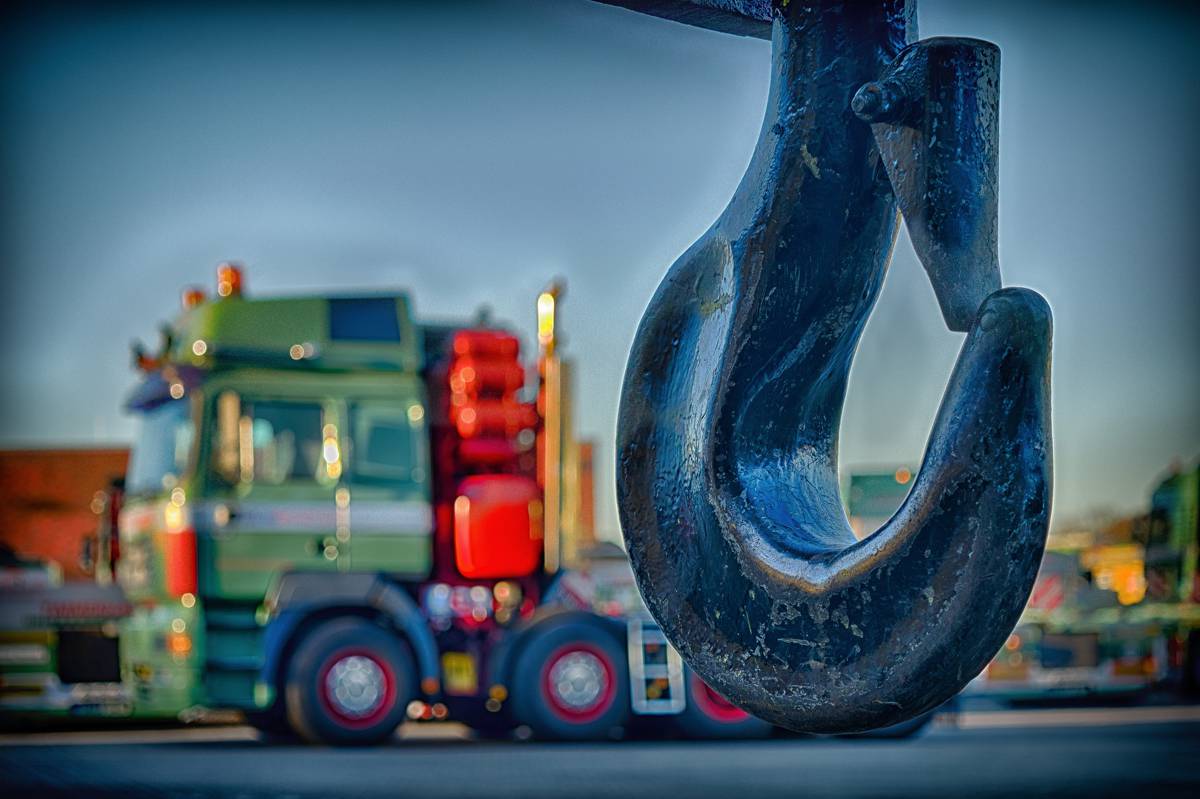
Essential Hand Signals for Crane Operations
The safe and efficient movement of big loads on a building site relies heavily on the use of cranes, and crane hand signals are an integral element of this.
Learning the standard crane hand signals allows a signal person to safely guide a crane operator to do tasks such as raising and lowering the boom, hoisting and lowering the cargo, moving the load horizontally, and stopping the crane in an emergency.
The Occupational Safety and Health Administration (OSHA) mandates that anybody designated as a signal person fulfil particular credentials and be reviewed by a trained professional. Given that the BLS reports that more than 60% of construction accidents occur during the first year of a worker’s employment, it is necessary to provide training at the start.
This is a guide on the fundamentals of how to use crane hand signals , including a few signs unique to telescopic, crawler, and tower cranes. Regardless of whether you’re working with a tiny carry deck crane or a massive all-terrain crane, or even the biggest crane in the world, you’ll need to know some basic crane hand signals.
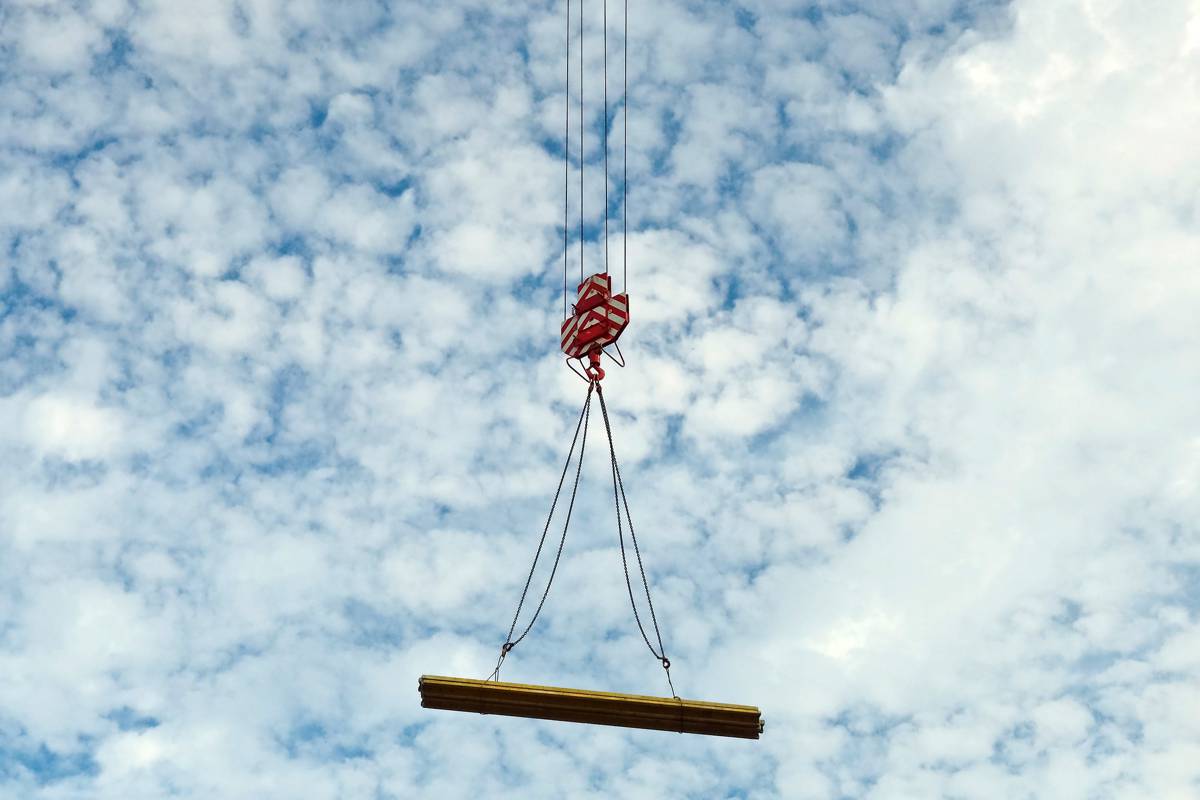
Stop Signals
Crane operation relies heavily on stop signals, which allow a signal person to rapidly convey the requirement to halt movement and activities.
Extend one arm out to the side, palm down, then bring it in toward your chest and out to the side again to signal a stop. For an emergency halt, extend both arms palms down, then swing arms back and forth, contacting the chest, then back out to the sides. To indicate dog everything, clasp both hands together and place them in front of the navel.

Boom and Load Signals
The long arm that projects from a crane is called a “boom,” and the operator receives instructions to either extend or retract the boom. Typically, there are three types of boom signals:
- Raise boom . Stretch one arm wide and point the thumb upward with the fist closed.
- Lower the boom . Hold your arm outstretched, with your fist closed, and your thumb pointing down.
- Swing boom . Stretch your arm outward and point your index finger in the direction the boom should move.
Load signals indicate to the crane operator whether the load should be raised or lowered using the crane’s hoist, which is a long chain with a hook that attaches to the load.
There are two common load signals, hoist, and lower load. Extend one arm vertically, pointing toward the sky, and make little clockwise circles with the hand to indicate a hoist load. Extend one arm vertically, point a finger toward the ground, and make little clockwise circles with the hand to indicate a lower load.
To maintain the crane within its safe working limitations , you may need to utilize a combination of orders to account for the load radius changing as the boom is raised and lowered. To indicate raise the boom and lower load, hold out one arm, point the thumb skyward, then open and close the other fingers. You may also indicate to lower the boom and hoist load by stretching your arm outward and pointing your thumb downward while opening and shutting your other fingers.
In addition, telescopic cranes, which have extendable and retractable booms, have their own set of boom instructions. To sign telescope out, hold your hands at your waistline with your thumbs facing outward and your fists closed. You may also sign telescope in, by holding your hands out in front of you with your thumbs pointing inward and your fists locked at waist level.

Travel Signals
Cranes may be moved in any direction, and the operator can be instructed on the safest manner to do so by using hand signals.
- Travel (Mobile Cranes) . With the hand stretched out in front of the body, point the fingers upward while pressing in and out in the direction of motion.
- Trolley Transport (Tower Cranes) . Make a fist with your other fingers while pointing your thumb in the direction you want to go. To signify back-and-forth movement, rock your thumb.
- Transport (Both Tracks-Crawler Cranes) . Spin the hands in front of the torso with closed fists. A forward rotation signifies forward motion, whereas a reverse rotation indicates backward motion.
- Travel (One Track-Crawler Cranes) . Raise one hand to indicate which track has to be locked, and then spin the other fist in front of the body to show the direction of travel.

Final Thoughts
Cranes, whether they are little carry deck cranes or massive all-terrain cranes, may weigh thousands of pounds and carry tremendous loads, thus their safe operation must be ensured by the use of crane hand signals. The use of standardized hand signals aids in the continuity of project sites and enhances safety across the construction sector.
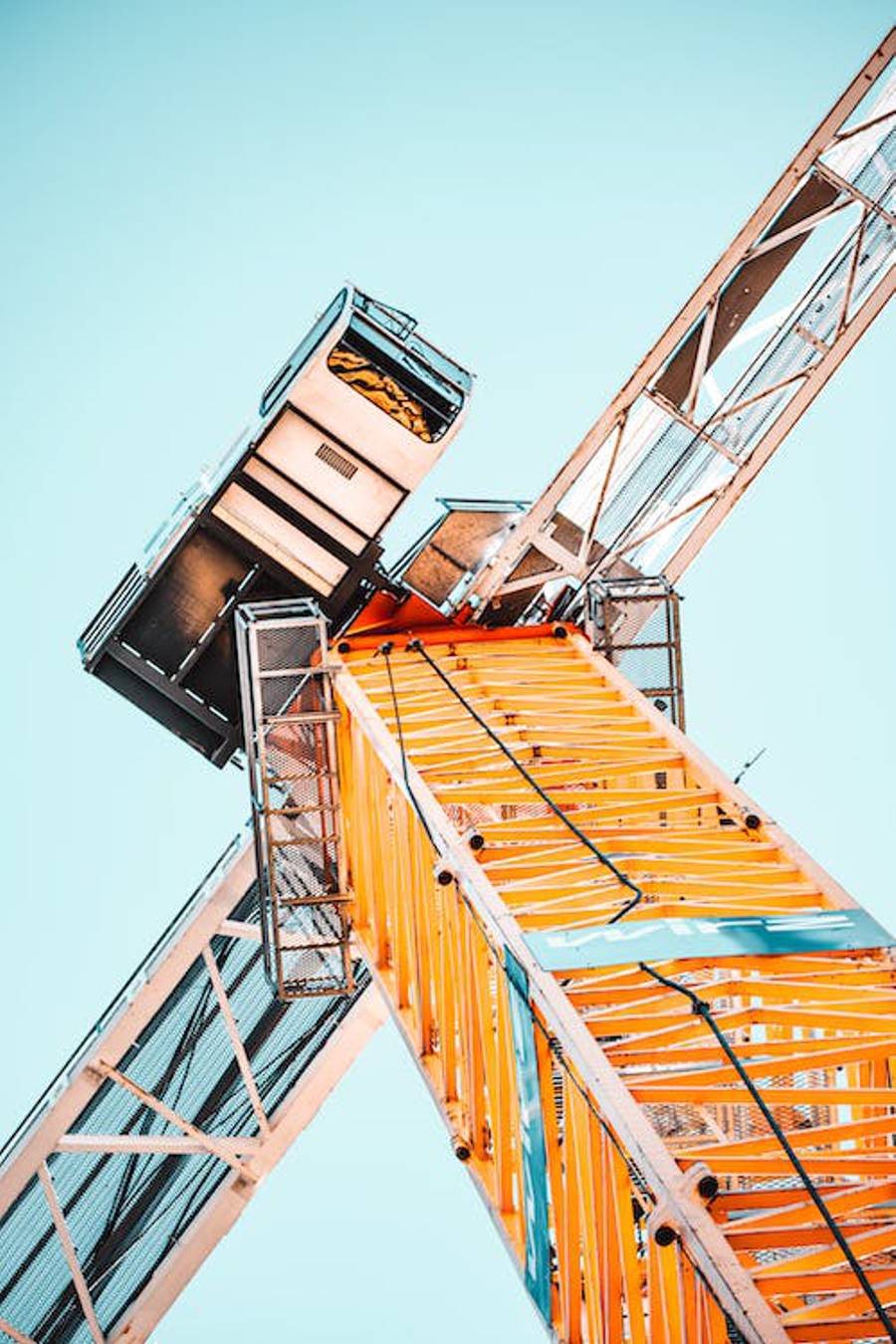
About The Author
Anthony has worked in the construction industry for many years and looks forward to bringing you news and stories on the highways industry from all over the world.
Related posts
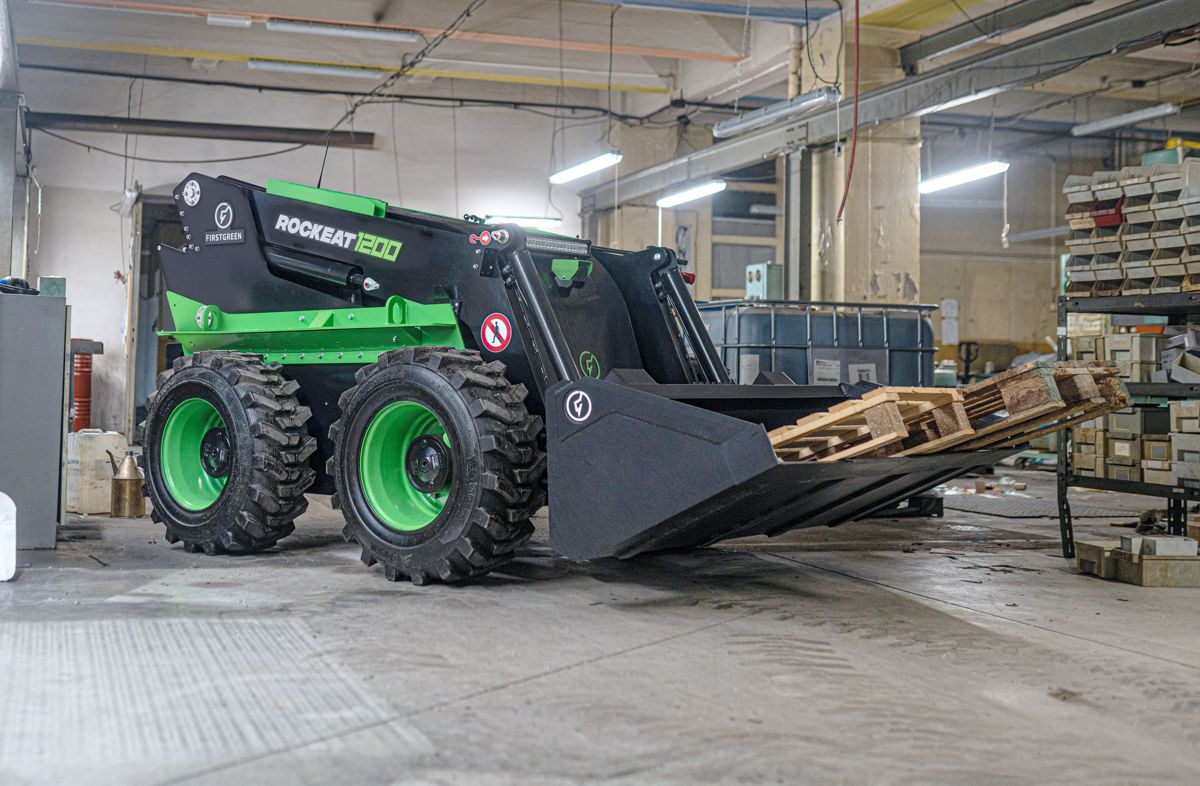
Trelleborg Brawler Solid Tires tackle the Recycling Industry
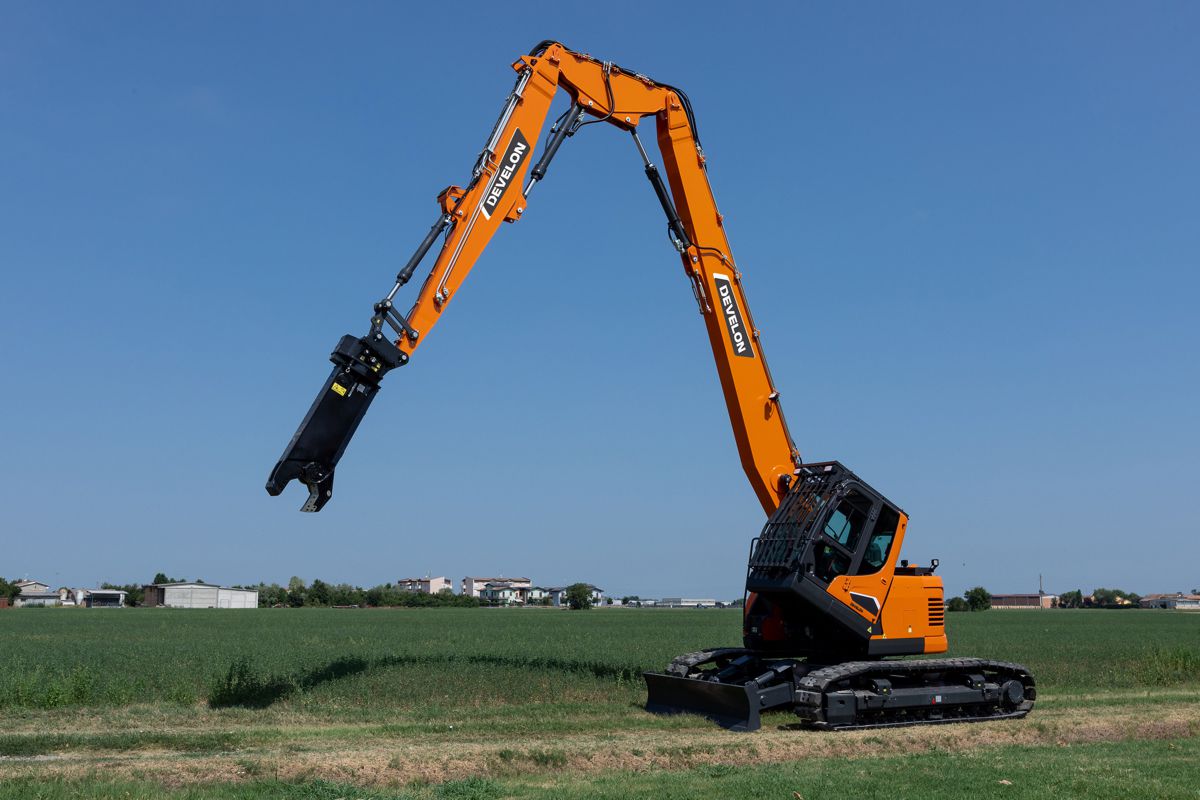
Develon announces new DX140RDM-7 Demolition Excavator
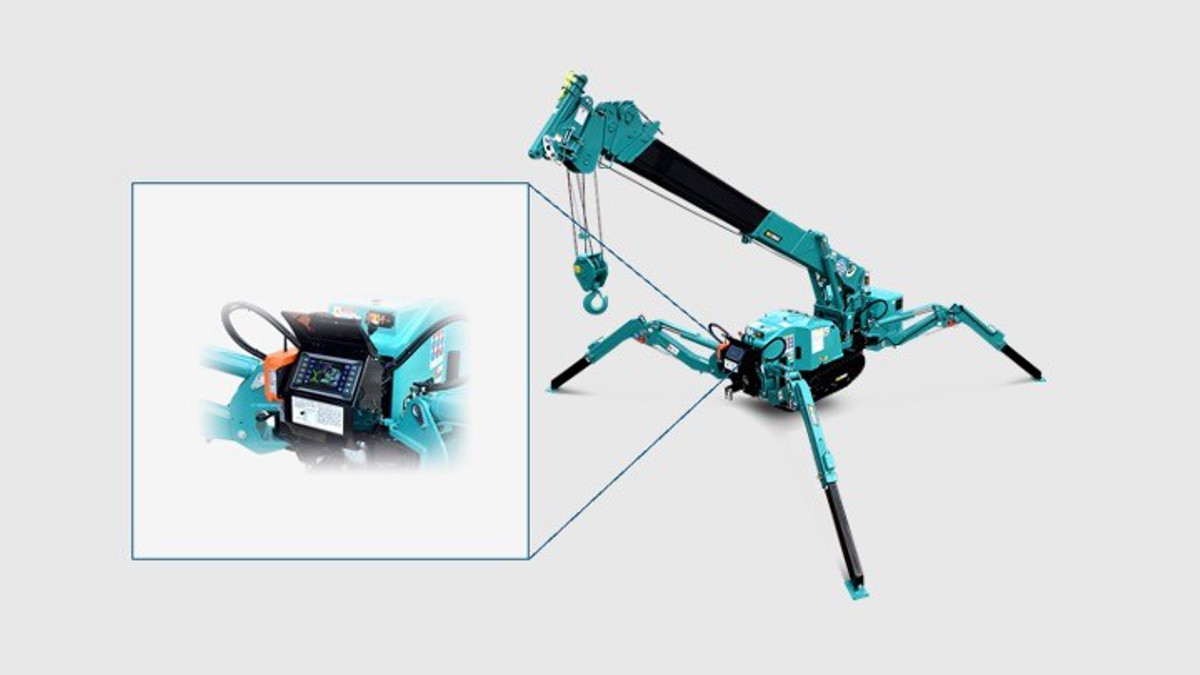
Maeda enters partnership with Trackunit ahead of Intermat debut
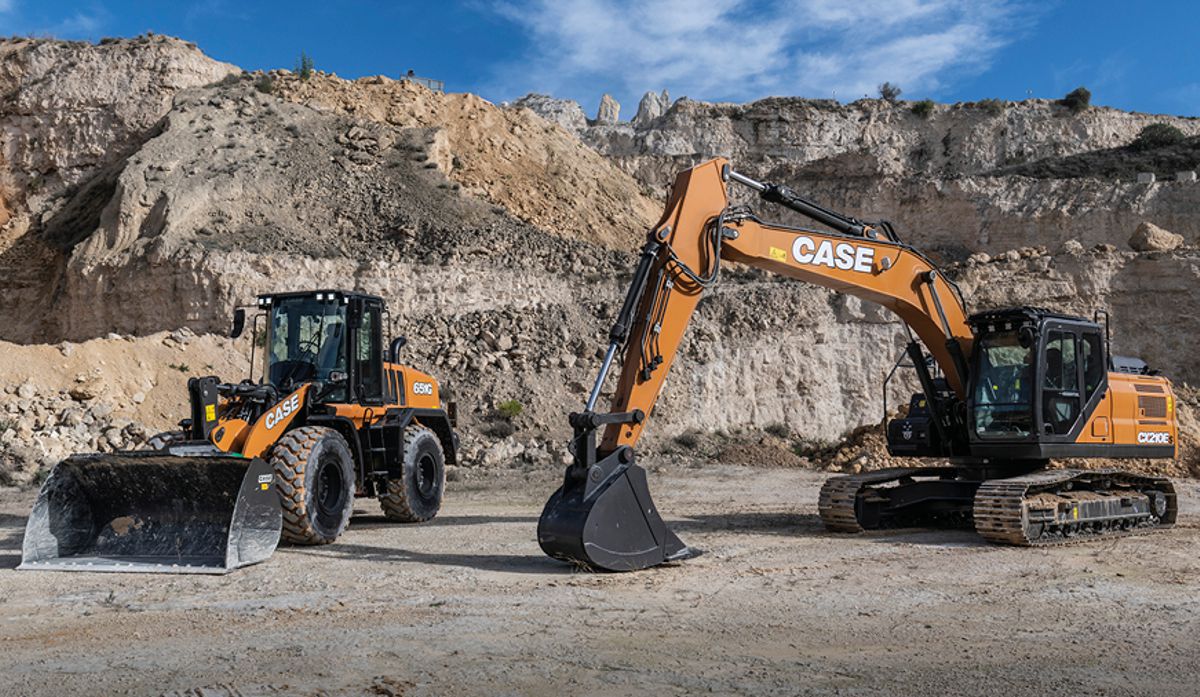
CASE to showcase their Electric Future at Hillhead 2024

New digital platform created for Liebherr used machinery
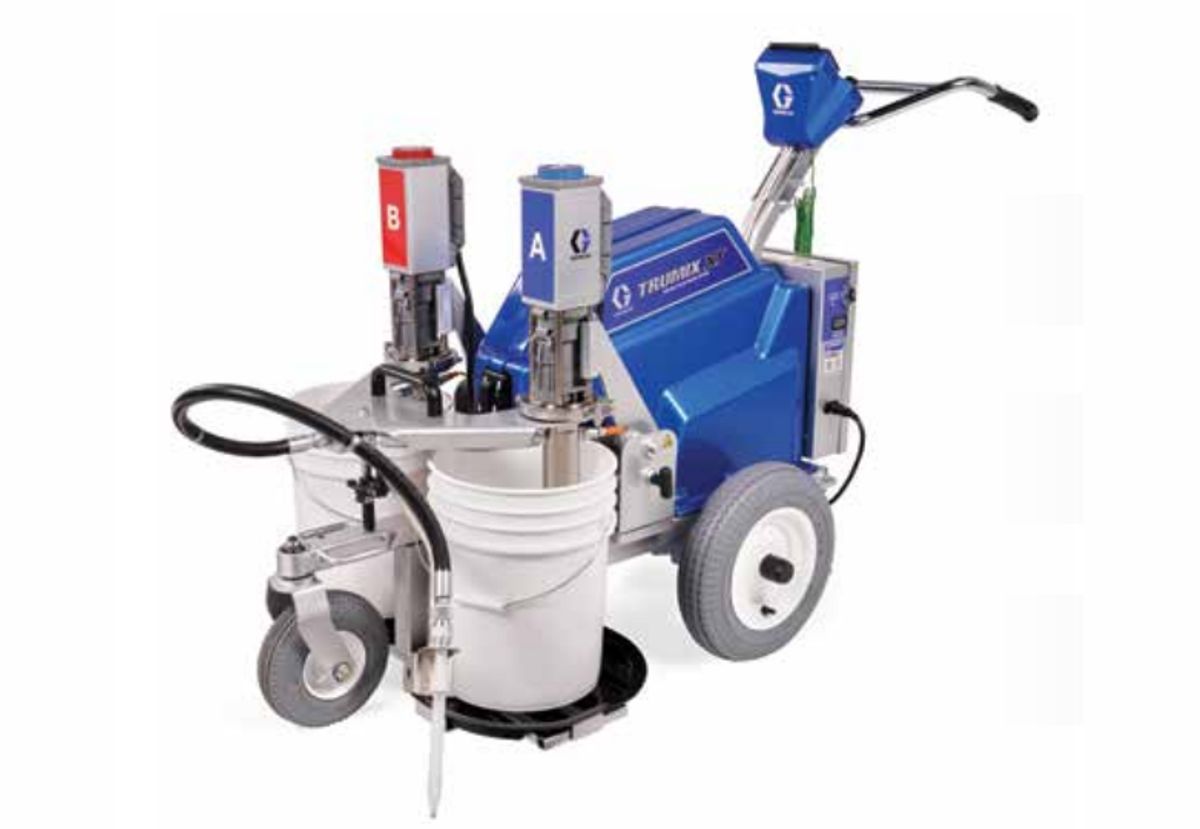
Graco announces new TruMix XT Variable-Ratio Paint Mixing System

Famous Mining Family put TrackGrip to the Ultimate Test in Alaska
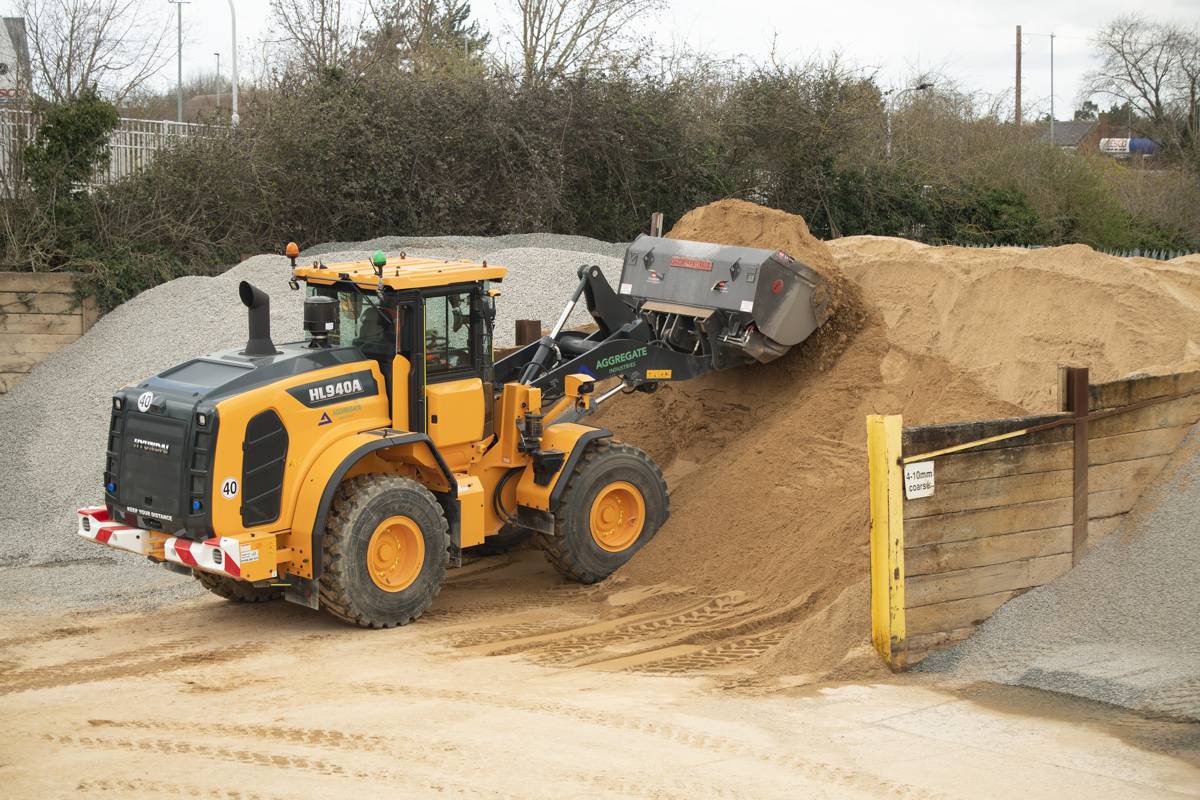
Aggregate Industries adds 21 HD Hyundai Wheel Loaders to its fleet

Privacy Overview
Crane Hand Signals to Know for a Safe Construction Site
Cranes are the most effective way to move heavy loads on a construction site, and proper use of crane hand signals is a vital part of safe operation. After learning basic crane hand signals, a signal person is able to safely direct a crane operator to raise and lower the boom, hoist and lower the load, or move the load horizontally — and, of course, to stop the crane in case of emergency.
Importantly, the Occupational Safety and Health Administration requires that anyone designated as a signal person must meet certain qualifications and be evaluated by a qualified individual. These regulations and a commitment to standardized signals have helped reshape the landscape of crane safety, with crane-related deaths falling to their lowest recorded level in 2017 according to the Bureau of Labor Statistics .
Below, we have a visual guide to basic crane hand signals, including a few signals that are particular to telescopic, crawler and tower cranes . In any case, crane hand signals are essential whether using a small carry deck crane or a larger all-terrain crane —these signals are even used with the largest cranes in the world .
Read on for a list of signals, or jump straight to our infographic and a downloadable version of the crane hand signals chart .
Stop Signals
Stop signals are the most important signals for crane operation because they enable a signal person to quickly communicate the need to cease movement and activity.
- Stop : Extend one arm, palm down, then swing the arm back and forth, touching the chest, then back out to the side.
- Emergency stop : Extend both arms with palms down, then swing arms back and forth, touching the chest, then back out to the sides.
- Dog everything : Clasp both hands together and hold them in front of the navel.
Boom and Load Signals
Boom signals instruct the crane operator to raise or lower the boom, which is the long arm extending out from a crane. There are three common boom signals:
- Raise boom : Extend an arm outward and point the thumb upward with a closed fist.
- Lower boom : Extend an arm outward and point the thumb downward with a closed fist.
- Swing boom : Extend an arm outward, pointing with an index finger in the direction the boom should swing.
Load signals instruct the crane operator to raise or lower the load using the crane’s hoist, which is the long chain with a hook that attaches to the load. There are two common load signals:
- Hoist load : Extend an arm vertically, pointing a finger toward the sky, and make small clockwise circles with the hand.
- Lower load : Extend an arm vertically, pointing a finger toward the ground, and make small clockwise circles with the hand.
Keep in mind that raising and lowering the boom changes the load radius, so you may need to use combination commands to keep the crane within safe operating limits. There are two common combination commands:
- Raise boom and lower load : Extend an arm outward and point the thumb upward, opening and closing the other fingers.
- Lower boom and hoist load : Extend an arm outward and point the thumb downward, opening and closing the other fingers.
There are also a few boom commands that are specific to telescopic cranes, which have booms that can extend and retract. There are two essential commands for telescopic cranes:
- Telescope out : Place the hands at waist level and point the thumbs outward, fists closed.
- Telescope in : Place the hands at waist level and point the thumbs inward, fists closed.
Travel Signals
Cranes themselves can be moved, and hand signals help communicate to the operator how to move the crane in a safe way in the desired direction.
- Travel (Mobile Cranes) : Point the fingers upward with the hand extended out in front of the body, pushing in and out in the direction of travel.
- Trolley Travel (Tower Cranes) : Point a thumb in the direction of travel, palm facing upward and other fingers closed in a fist. Move thumb back and forth to indicate travel.
- Travel (Both Tracks — Crawler Cranes) : Rotate the hands with closed fists in front of the body. Rotation toward the body indicates travel forward, while rotation away from the body indicates travel backward.
- Travel (One Track — Crawler Cranes) : Raise a fist to indicate which track to lock, then rotate the other fist in front of the body to indicate direction of travel.
Crane Hand Signals Promote Jobsite Safety
Knowledge of crane hand signals helps to ensure the safe operation of cranes —whether small carry deck cranes or large all-terrain cranes — which often weigh thousands of pounds and carry enormous loads. Using standardized hand signals helps maintain continuity between job sites and promotes safety across the entire construction industry .
Download a PDF version of our crane hand signals reference chart below to take with you to the job site.
Below, see a visual reference of all of the most important crane hand signals that anyone working on a construction site should know.
Leave a Comment Cancel Reply
Your email address will not be published. Required fields are marked *
Save my name, email, and website in this browser for the next time I comment.
Need help? Call our award-winning support team 24/7 at 718-644-5978
Staten Island
- 718-644-5978
- 1402 Richmond Terrace, Staten Island, NY 10310
- [email protected]
- 718-757-6988
- 88 9th Street, Brooklyn, NY 11215
- [email protected]
- 58-67 56th Street, Maspeth, NY 11378
- [email protected]
Manhattan Office
- 299 Pearl Street, New York, NY 10038
- [email protected]
The heart and soul of NYC Tool Rental comes down to one thing and one thing only: helping people. You, our customer, are who we design all our services and technologies around and you have inspired our three-word philosophy – Built around you. This philosophy is the behind everything we do. It’s what defines us and is what sets us apart in the industry.
Quick Links
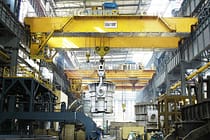
- Steel Industry
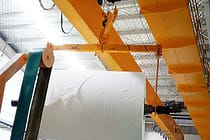
- Paper Industry
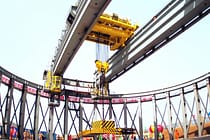
- Power Industry
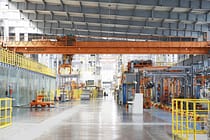
- Automobile Industry
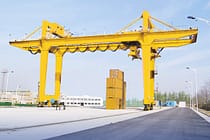
- Port Machines Industry

- Manufacturing Industry
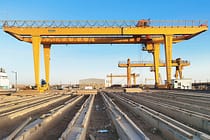
- Precast Concrete Plant
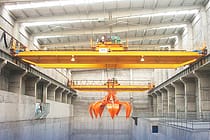
- Waste to Energy and Biomass Industry

Overhead Cranes
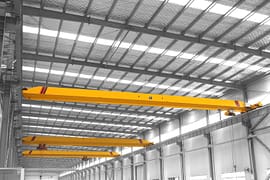
Single Girder Overhead Crane
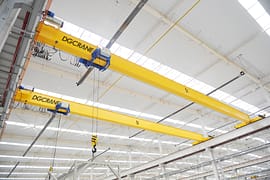
- Single Girder Eot Cranes
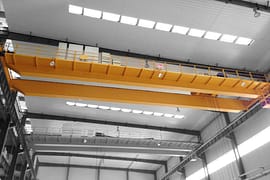
- Double Girder Eot Cranes
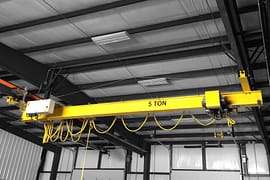
- Underslung Cranes
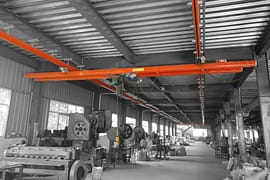
- Workstation Overhead Cranes
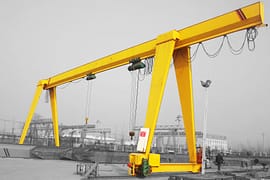
- Single Girder Gantry Cranes
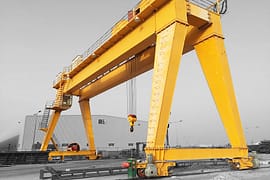
- Double Girder Gantry Cranes
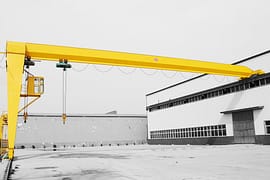
- Semi Gantry Cranes
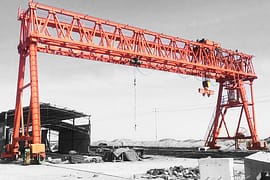
- Casting Yard Gantry Cranes
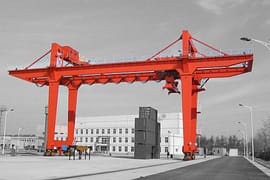
- Container Gantry Cranes (RMG)
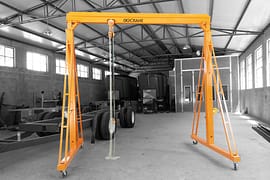
- Portable Gantry Cranes
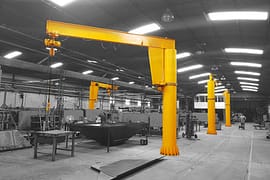
- Free Standing Jib Cranes
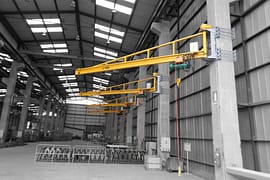
- Wall Mounted Jib Cranes
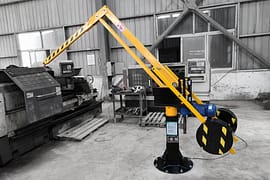
- Balance Jib Cranes
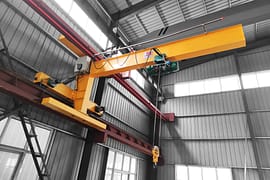
- Wall Travelling Jib Cranes
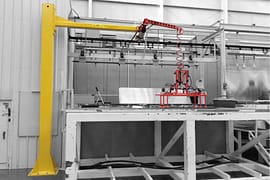
- Articulating Jib Cranes
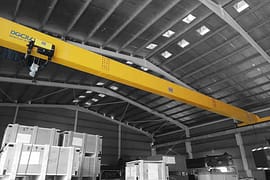
- FEM Standard Overhead Cranes
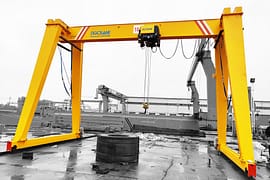
- FEM Standard Gantry Cranes
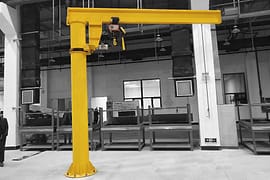
- FEM Standard Jib Cranes
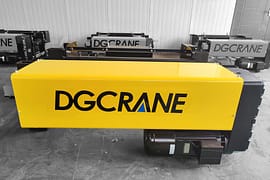
- FEM Standard Wire Rope Electric Hoists
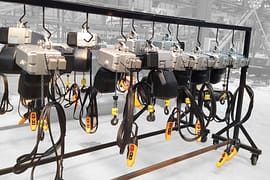
- FEM Standard Electric Chain Hoists
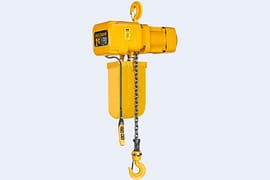
- Chain Hoists
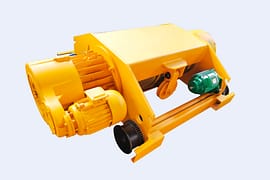
- Crane Trolley
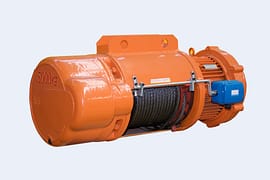
- Electric Wire Rope Hoists
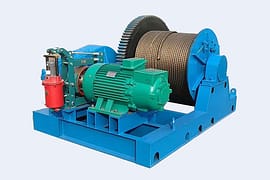
- Electric Winch
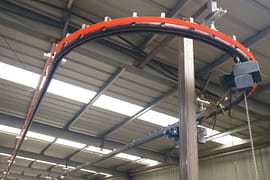
- Monorail Overhead Cranes
- Workstation Jib Cranes
- Electric Hoists
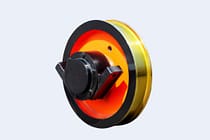
- Crane Wheels
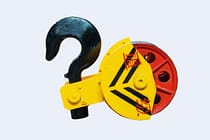
- Crane Hooks
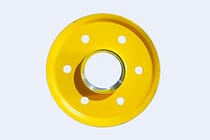
- Crane Sheaves
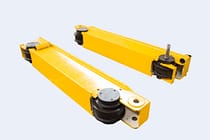
- Crane End Carriages
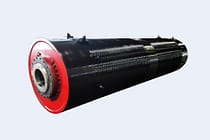
- Crane Rope Drums

- Crane Coupling
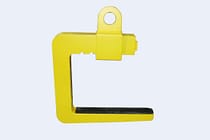
- Crane Spreader
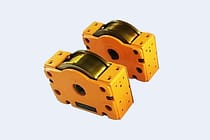
- DRS Wheel Blocks System

- Crane Power Supply System
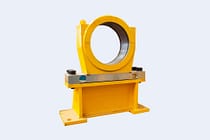
- Other Crane Parts
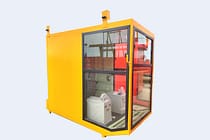
- Crane Cabin
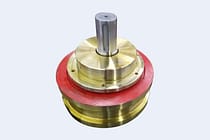
- Crane Wheel Block Assembly

- Crane Buffers
CRANE PARTS
Crane hand signals for overhead and gantry crane.
In industrial settings where overhead cranes and gantry cranes are utilized, it is crucial to have a clear and effective communication system between the crane operator and the signal person. While technology has provided advancements in remote control systems, understanding and using hand signals remain an essential part of crane operations. In this article, we will explore the significance of mastering crane hand signals and how they contribute to ensuring safe and efficient lifting operations.
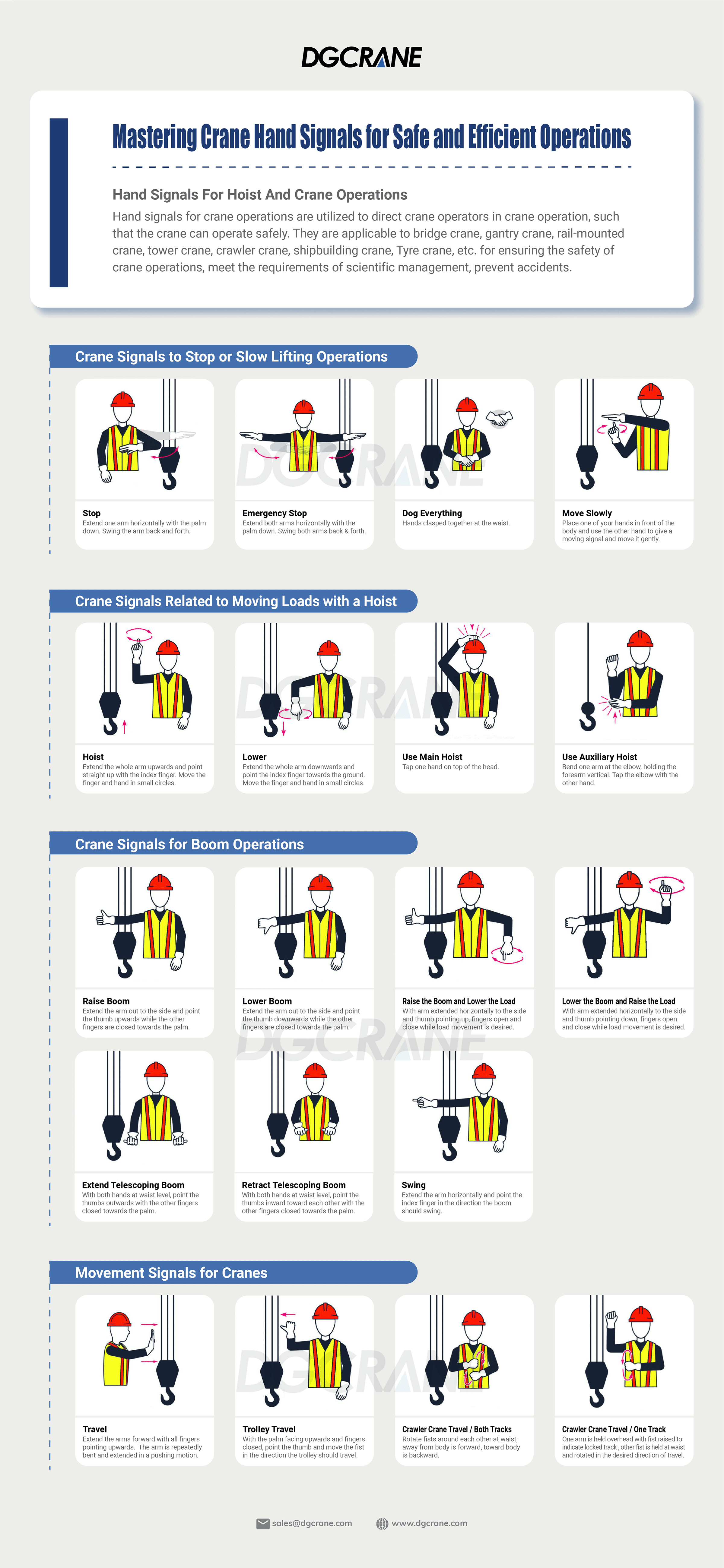
Part 1: Crane Signals to Stop or Slow Lifting Operations
When it comes to stopping or slowing down lifting operations, specific hand signals are used to communicate with the crane operator. These signals include:
- Stop: The signal is used to halt all crane operations immediately. When the ground personnel extends their arm horizontally with the palm facing downward, it indicates that the crane operator should stop all movements.
- Emergency Stop: In critical situations requiring an immediate halt of all operations, the signal is used. The ground personnel will repeatedly swing their raised arm in a horizontal motion, signaling the need for an emergency stop.
- Dog Everything: The signal instructs the crane operator to secure or lock all crane functions. The ground personnel will form a closed fist with their hand and move it in a circular motion, indicating that all crane movements should be locked.
- Move Slowly: When a slower movement is necessary, the signal is employed. The ground personnel will extend their arm horizontally with the palm facing downward and make a slow, waving motion. This indicates that the crane operator should reduce the speed of all movements.
These signals are crucial in situations where precision and caution are required, such as when approaching obstacles, positioning loads, or during critical phases of the lifting process.
Part 2: Crane Signals Related to Moving Loads with a Hoist
When moving loads with a hoist, the signal person communicates the desired actions to the crane operator using specific hand signals. These signals include:
- Hoist: Clench both hands and move them upward simultaneously. This signal instructs the operator to engage the hoist and begin lifting the load.
- Lower: Extend one arm vertically with the palm facing downward and move it upward and downward in a repeated motion. This signal indicates the need to lower the load.
- Use Main Hoist: The signal is used to instruct the crane operator to utilize the primary hoist. The ground personnel will form a closed fist and extend their arm outward, indicating the use of the main hoist function.
- Use Auxiliary: When the auxiliary hoist is required for lifting operations, the ground personnel will extend their arm outward with the thumb raised, signaling the crane operator to utilize the auxiliary hoist.
Clear and precise communication through these signals ensures that the load is moved safely and accurately, preventing accidents or damage to the load and surrounding equipment.
Part 3: Crane Signals for Boom Operations
During boom operations, where the crane's arm or boom is utilized, specific hand signals are employed to indicate the desired movements. These signals include:
- Raise Boom: The signal instructs the crane operator to elevate the boom. The ground personnel will extend their arm vertically and make a slow, upward motion, imitating the movement of raising the boom.
- Lower Boom: To indicate the need for lowering the boom, the ground personnel will extend their arm vertically and make a slow, downward motion, resembling the movement of lowering the boom.
- Raise the Boom and Lower the Load: When both raising the boom and lowering the load are required simultaneously, the ground personnel will extend one arm upward and the other arm downward, making distinct vertical motions to convey the specific instructions.
- Lower the Boom and Raise the Load: Conversely, to lower the boom and raise the load simultaneously, the ground personnel will extend one arm down and the other arm upward, performing clear vertical motions to communicate the necessary actions.
- Extend Telescoping Boom: For cranes equipped with telescoping booms, the ground personnel will extend their arms outward in opposite directions, illustrating the extension of the telescoping boom.
- Retract Telescoping Boom: When the telescoping boom needs to be retracted, the ground personnel will bring their extended arms together, mimicking the movement of retracting the telescoping boom.
- Swing: The signal indicates the need for the crane operator to rotate the crane's superstructure. The ground personnel will extend their arm horizontally and make a circular motion, indicating the desired direction of the swing.
Mastering these hand signals is essential for safe and efficient boom operations, especially when precise positioning or navigating obstacles is required.
Part 4: Movement Signals for Cranes
Apart from specific lifting and boom operations, hand signals are also used to communicate the general movements of the crane. These signals include:
- Travel: To instruct the crane operator to move the entire crane, the ground personnel will extend their arm horizontally and point in the desired direction of travel.
- Trolley Travel: For overhead cranes with trolley movement, the ground personnel will extend their arm horizontally and move it in a horizontal back-and-forth motion, imitating the movement of a trolley.
- Crawler Crane Travel/Both Tracks: In the case of crawler cranes with tracks, the ground personnel will extend their arms outward and move them in a circular motion, signifying the need for travel using both tracks.
- Crawler Crane Travel/One Track: When a crawler crane needs to travel using only one track, the ground personnel will extend one arm outward and keep the other arm close to their body, indicating the desired direction of travel.
These signals are crucial for maintaining safe distances, avoiding collisions, and ensuring overall control and coordination during crane operations.
Mastering crane hand signals is essential for maintaining a safe working environment in industries that utilize overhead and gantry cranes. Effective communication between the signal person and the crane operator significantly reduces the risk of accidents, enhances productivity, and ensures precise positioning of loads. Safety should always be a top priority in industrial operations, and the proper use of hand signals contributes to achieving that goal.
Remember, by understanding and following the hand signals discussed in this article, we can promote a culture of safety and ensure the smooth and efficient operation of overhead and gantry cranes.
Q: Why is it important to master crane hand signals? A: Mastering crane hand signals is crucial for effective communication between the signal person and the crane operator, ensuring safe and efficient lifting operations.
Q: Are hand signals still relevant in the age of remote-controlled cranes? A: While technology has advanced, hand signals remain a vital backup communication method and a necessary skill for crane operators and signal persons.
Q: What should I do if I am unsure about a hand signal? A: If you are uncertain about a hand signal or its meaning, always clarify with the signal person or the crane operator before proceeding with any movements.
Q: How can I ensure proper understanding and coordination when using hand signals? A: Regular training, clear communication protocols, and ongoing practice sessions between the signal person and crane operator are key to ensuring proper understanding and coordination of hand signals.
Q: Are there any industry standards for crane hand signals? A: Yes, various industry organizations, such as OSHA, ANSI, and ASME, provide guidelines and standards for crane hand signals that should be followed for safe operations.
Related Blogs
The difference of hoists and cranes(with common types), read full story, inspection and discard criteria of wire ropes, care and maintenance of wire ropes: in the whole 6 stages, free download pdf-iso 4309 cranes-wire ropes-care and maintenance, inspection and discard.
Subscribe to our newsletter
The latest DGCRANE price list, news, articles, and resources.
- Overhead Cranes
- Single Girder Overhead Cranes
- Gantry Cranes
- Hoist & Winch Trolley
- FEM Standard Crane & Hoist
- Light Cranes
- [email protected]
- +86-373-3876188
- +86 158 3611 5029
- Floor 30,Gongyuan INT'I Building, Jinsui Road, Xinxiang City, Henan Province, China
Follow DGCRANE:
TOOLBOXTOPICS.COM

IMAGES
VIDEO
COMMENTS
To signal for crawler cranes travel (both tracks), spin your hands with your other fingers closed into a fist in front of you. To indicate forward travel, you must rotate towards yourself. Rotation away from the body indicates backward travel. Crawler Crane Travel, One Track.
Travel Signals. Cranes themselves can be moved, and hand signals help communicate to the operator how to move the crane in a safe way in the desired direction. ... Travel (Both Tracks — Crawler Cranes): Rotate the hands with closed fists in front of the body. Rotation toward the body indicates travel forward, while rotation away from the body ...
simultaneous crane function signals. 5-3.3.6 Special Signals For operations or crane attachments not covered by para. 5-3.3.4, 5-3.3.5, or 5-3.3.7, additions to or modifications of ... (For crawler cranes only) TRAVEL (ONE TRACK) Indicate track to be locked by raising fist on that side. Rotate other fist in front of body in direction that other ...
Standard Hand Signals. FOR CONTROLLING MOBILE CRANE OPERATIONS HOIST. With upper arm extended . to the side, forearm and index finger pointing straight up, hand and finger make small ... body indicates travel backward. (For crawler cranes only) TRAVEL (ONE TRACK) Indicate track to be locked by raising fist on : that side. Rotate other
Crawler Crane Travel, Both Tracks - The signal person rotates both fists around each other in front of their body. Rotate the fists away from the body to signify forward travel and towards the body for backward travel. Crawler Crane Travel, One Track - The signal person raises one fist to indicate which track (left or right) should be ...
On a tracked crawler crane, moving one track causes the vehicle to turn, so the "both track" crawler travel signals control forward and reverse, while the "one track" signals control turning direction. ... Rotate one fist in front of the body to indicate the direction of movement as with "Crawler Crane Travel, Both Tracks." Use the ...
indicating direction of travel. (Note: Crawler cranes only.) Both fists in front of body with thumbs pointing in. Arm extended, fingers closed, thumb pointing down. Other arm bent slightly with forefinger pointing up and rotating in circle. MOBILE CRANE Ground Guide Signals 735 32 POSTER mobile crane.indd 1 1/23/14 11:48 AM From Page 32 of PS ...
Hand Signals for Crane Operations ... TRAVEL -- (both tracks, crawler cranes only) Use both fists in front of body, making a circular motion about each other to indicate the direction of travel - forward or backward. DOG EVERYTHING -- Clasp hands in front of the body. RAISE BOOM & LOWER LOAD -- Extend right arm with thumb pointing up, then flex ...
0:00 Hoist0:05 Lower0:10 Crawler Both Tracks Travel0:15 Crawler One Track Travel0:20 Trolley Travel0:25 Forward Crawl0:25 Backward Crawl0:30 Emergency Stop0:...
What are some signals for crawler cranes only? Lock Track: this side as indicated by raised fist. Turn Travel Track: this side in direction shown by revolving fist. ... Travel Both Tracks: forward or backward by revolving fists. Materials Handling - Crane and Hoist Hand Signals CCOHS. Travel Both Tracks. Fact sheet confirmed current: 2019-08-15 ...
Down and Raise the Load, Boom Up and Lower the Load and Travel. • This set of signals applies to crawler cranes: Travel-Both Tracks and Travel-One Track. • Cranes with telescoping booms also have specific signals: Telescope Out, Telescope In, Telescope Out (One hand signal), and Telescope In (One hand signal).
SWING -- Extend right arm away from body, point with finger in direction of swing of boom. STOP -- Right arm extended down with wrist bent and palm down and open. EMERGENCY STOP -- Right arm extended, palm down, then move hand rapidly right and left. TRAVEL - (both tracks, crawler cranes only) Use both fists in front of body, making a circular ...
New Crawler Crane Rules in NYC ... STANDARD HAND SIGNALS FOR CONTROLLING CRANE OPERATIONS. SWING: Arm extended, point with finger in direction of the swing of the boom. LOWER: Arm extended downward, forefinger pointing down, move hand in small horizontal circle. TRAVEL: (both tracks) Use both fists in front of body, making a circular motion ...
Appendix A to Subpart CC of Part 1926—Standard Hand Signals. STOP - With arm extended horizontally to the side, palm down, arm is swung back and fourth. ... CRAWLER CRANE TRAVEL, ONE TRACK - Indicate track to be locked by raising fist in front of body in direction that other ttrack is to travel. TROLLEY TRAVEL - With palm up, fingers closed ...
Warning device. Except for floor-operated cranes, a gong or other effective warning signal shall be provided for each crane equipped with a power traveling mechanism. When starting the bridge and when the load or hook approaches near or over personnel, the warning signal shall be sounded. Safety lights can be added to an existing crane as a ...
Travel Signals. Moving a crane can be dangerous, and someone needs to direct the operator on where to go. There are a few basic signals your team should be aware of and what they mean. ... CRAWLER CRANES (ONE TRACK) - Travel on crawler cranes, but one track will require a person to signal whether to go backward or forwards. One fist should ...
What are some signals for crawler cranes only? ... Turn Travel Track: this side in direction shown by revolving fist. Lock Track Turn Travel Track. Travel Both Tracks: forward or backward by revolving fists. Travel Both Tracks. Fact sheet confirmed current: 2019-08-15; Fact sheet last revised: 2013-09-05;
Travel (One Track-Crawler Cranes). Raise one hand to indicate which track has to be locked, and then spin the other fist in front of the body to show the direction of travel. Final Thoughts. Cranes, whether they are little carry deck cranes or massive all-terrain cranes, may weigh thousands of pounds and carry tremendous loads, thus their safe ...
Travel Signals. Cranes themselves can be moved, and hand signals help communicate to the operator how to move the crane in a safe way in the desired direction. Travel (Mobile Cranes): ... Travel (Both Tracks — Crawler Cranes): Rotate the hands with closed fists in front of the body. Rotation toward the body indicates travel forward, while ...
Part 4: Movement Signals for Cranes. Apart from specific lifting and boom operations, hand signals are also used to communicate the general movements of the crane. These signals include: Travel: To instruct the crane operator to move the entire crane, the ground personnel will extend their arm horizontally and point in the desired direction of ...
Cranes - Standard Hand Signals. Below are the standard hand signals used in the Construction Industry for Cranes. LEO is an equal opportunity employer/program. For additional assistance, please contact the Construction Safety and Health Division at 517-284-7680 or the Consultation Education and Training Division at 517-284-7720.
The following are the most commonly used hand signals for directing crane lifting operations. Some special operations may require adaptations of these basic signals. ... TRAVEL -- (both tracks, crawler cranes only) Use both fists in front of body, making a circular motion about each other to indicate the direction of travel - forward or backward.
When giving the ? signal, the signalperson must watch the crane for two-blocking. True. Raising the boom decreases the load radius, which increases the load capacity of the crane. ... Crawler crane travel, both tracks. The ? signal is performed with both fists rotating around each other in a circular motion in front of the body.